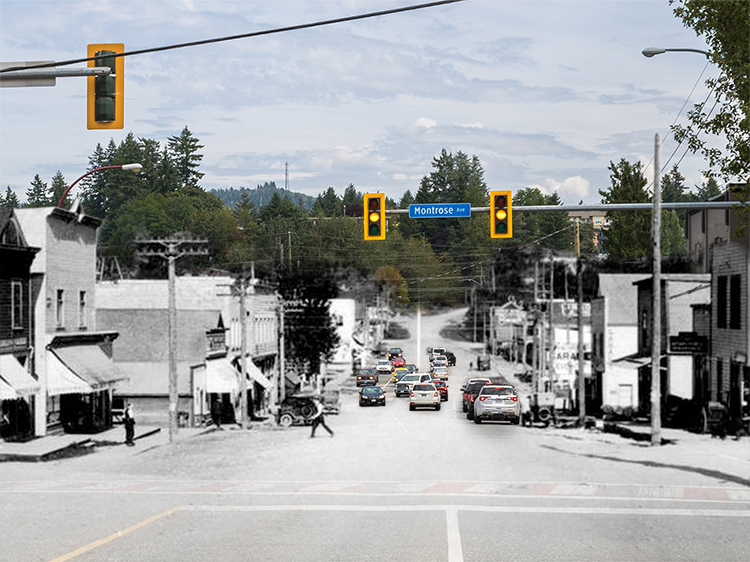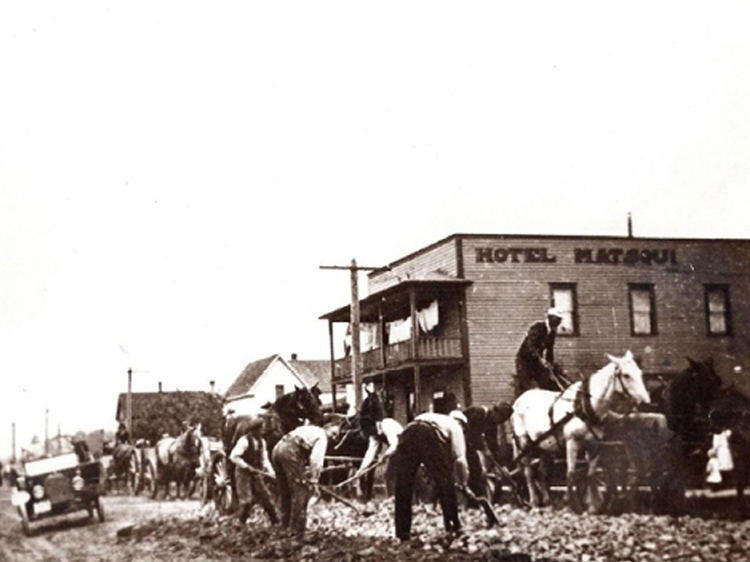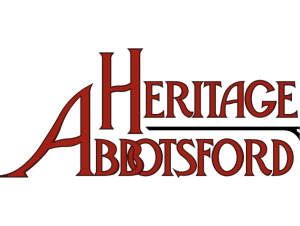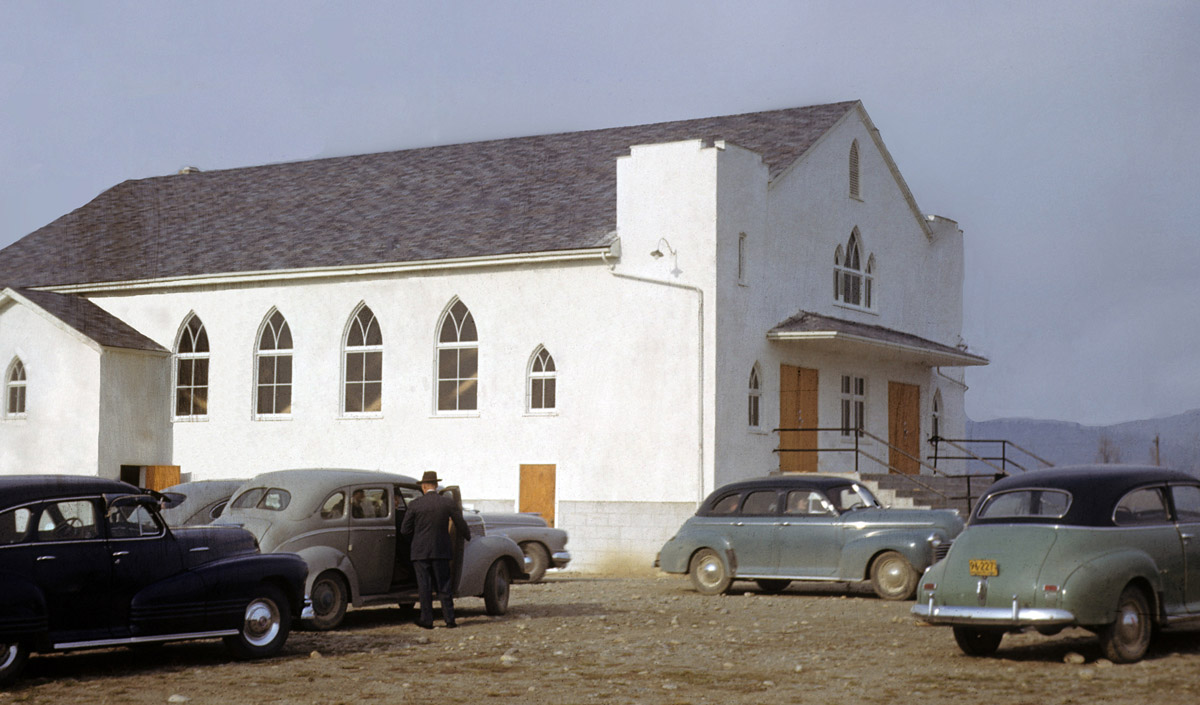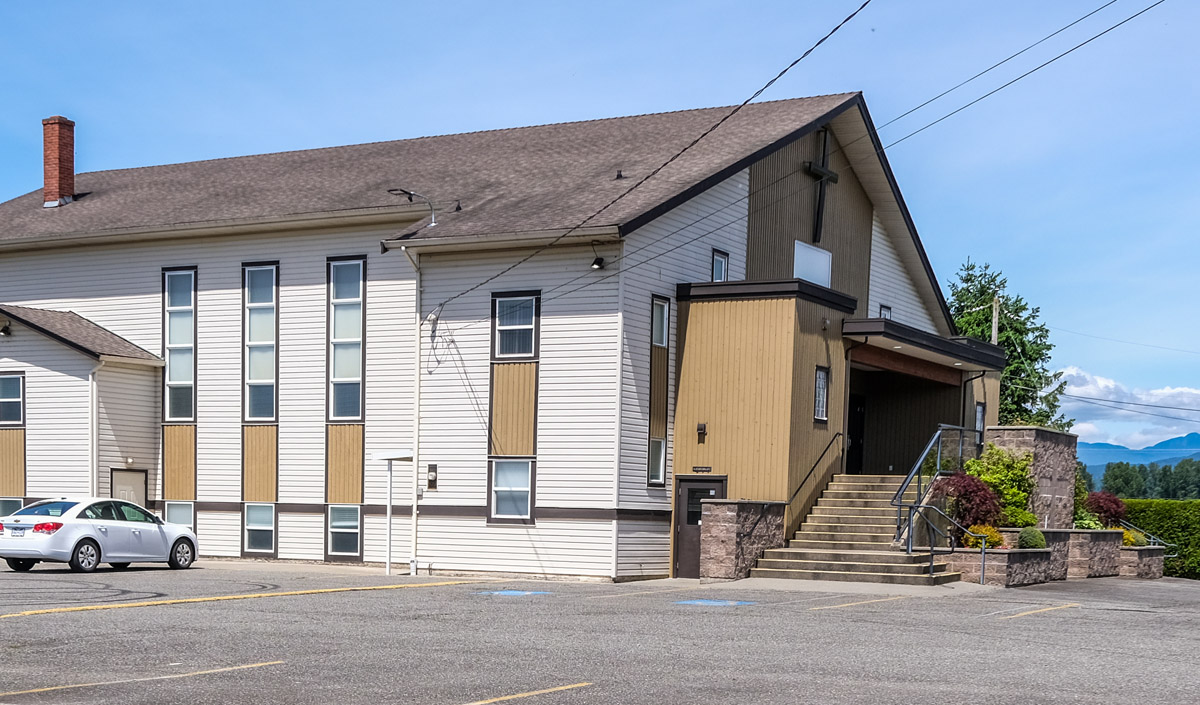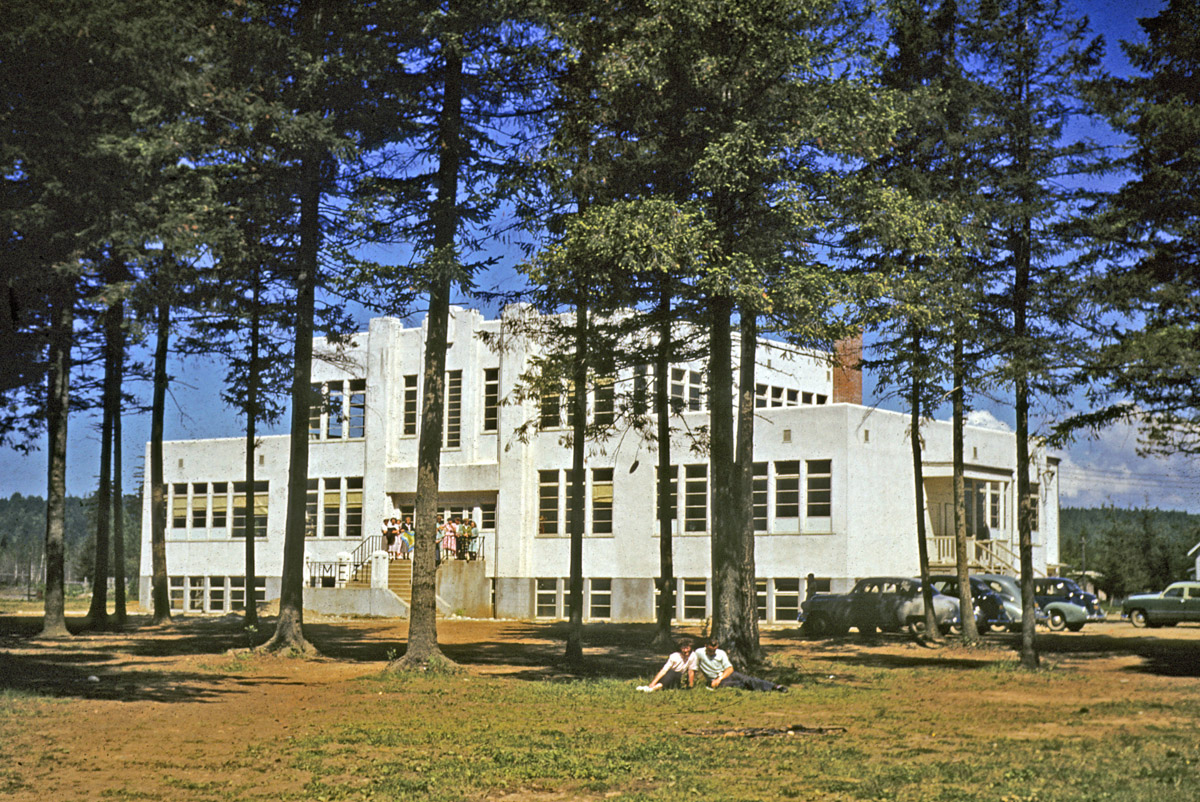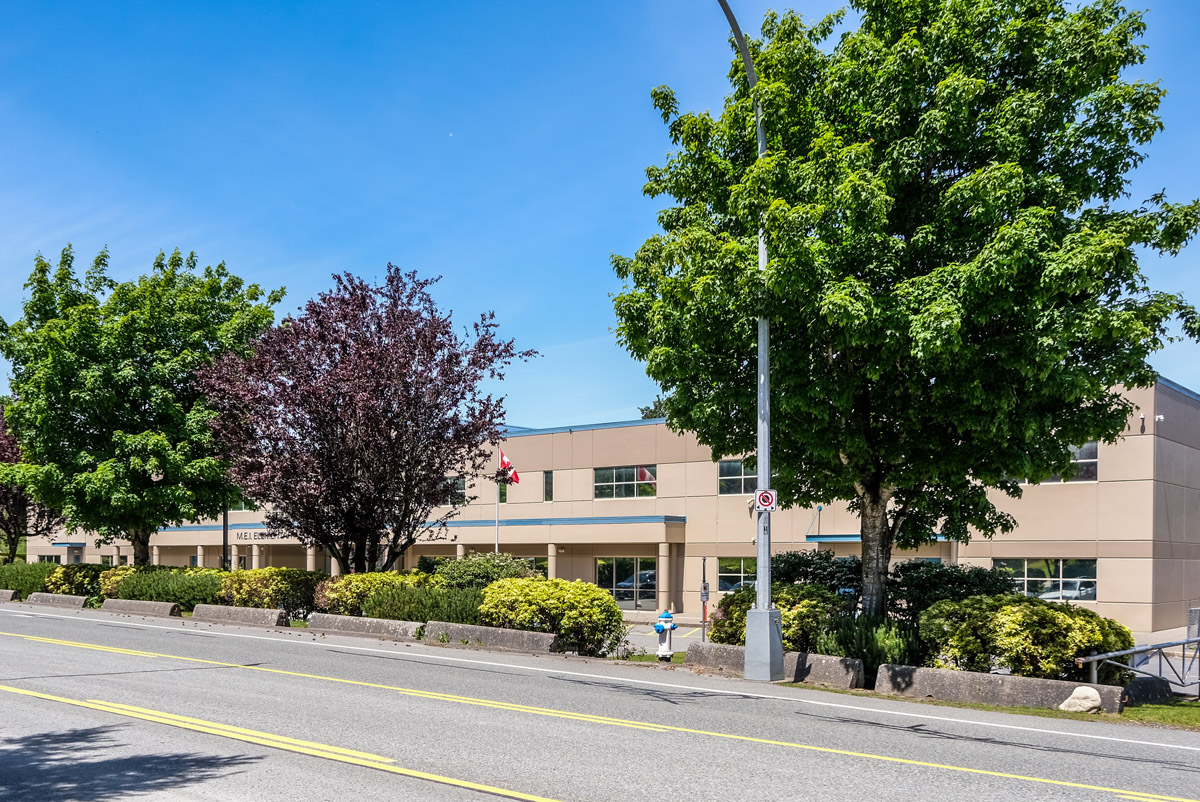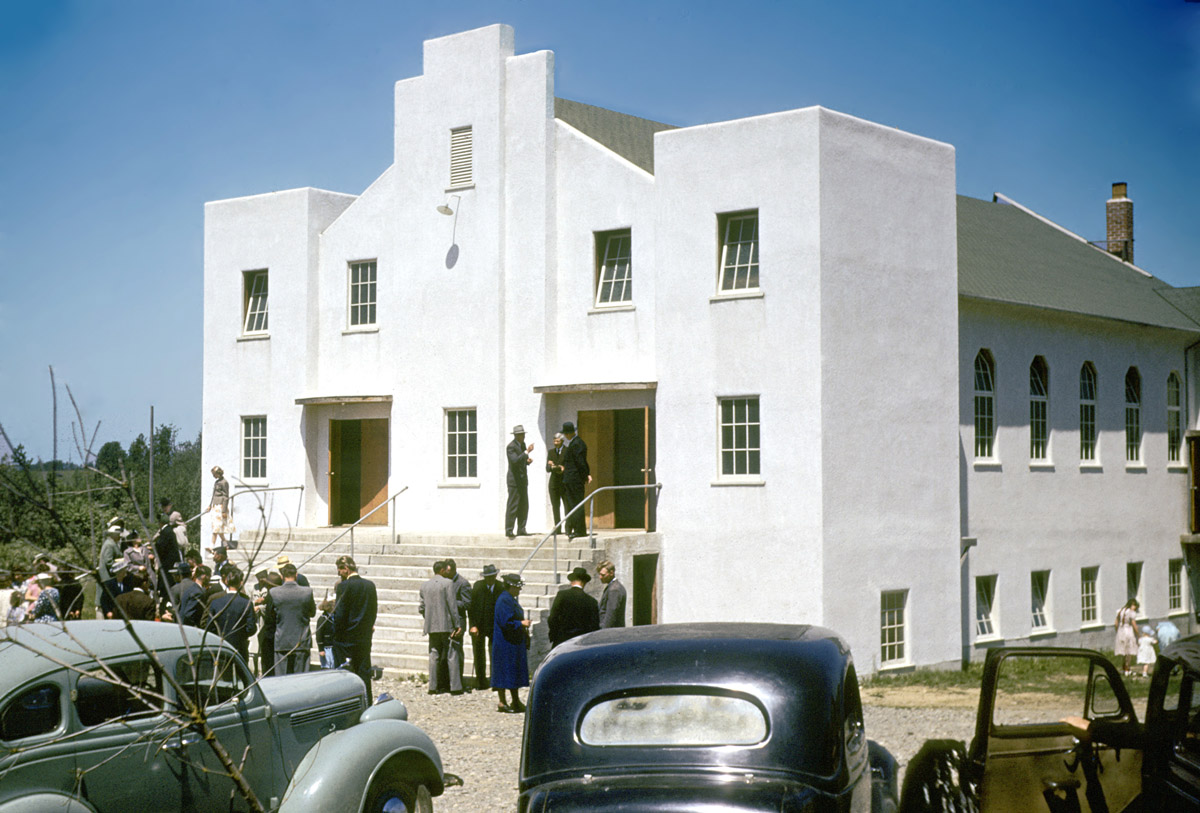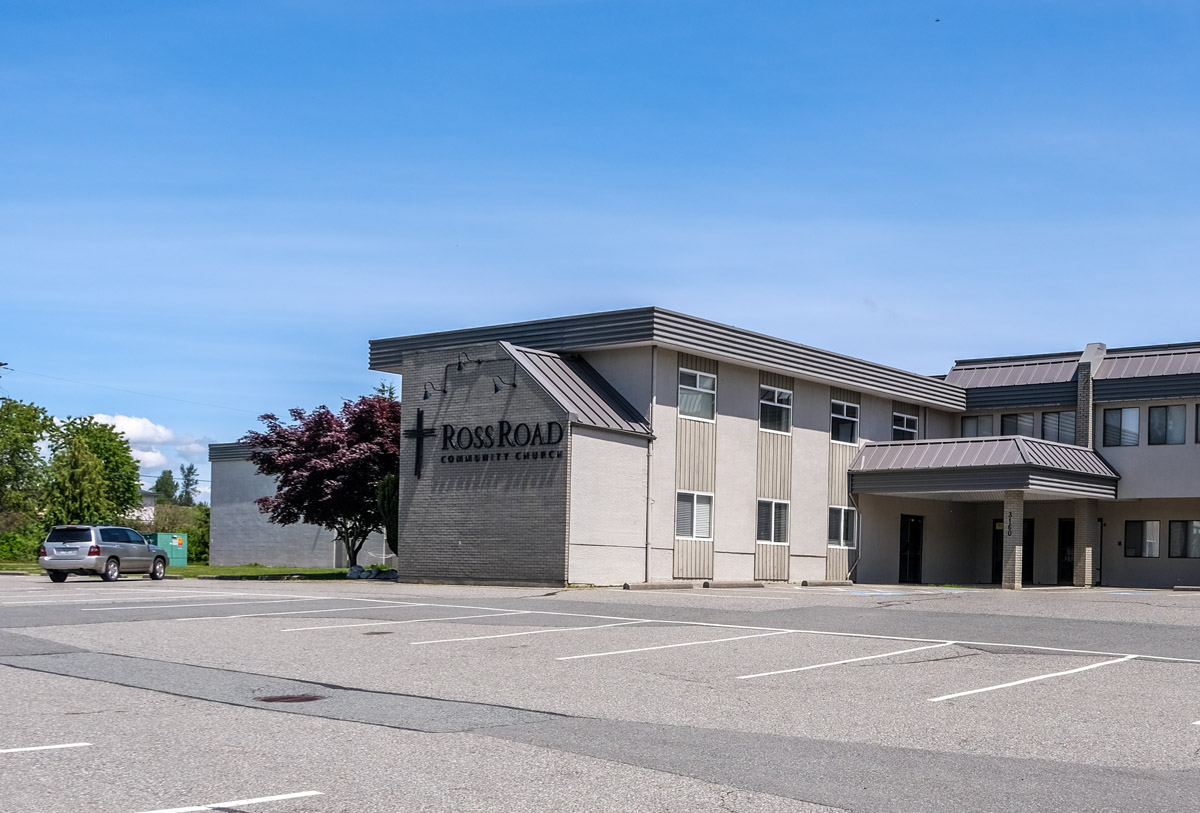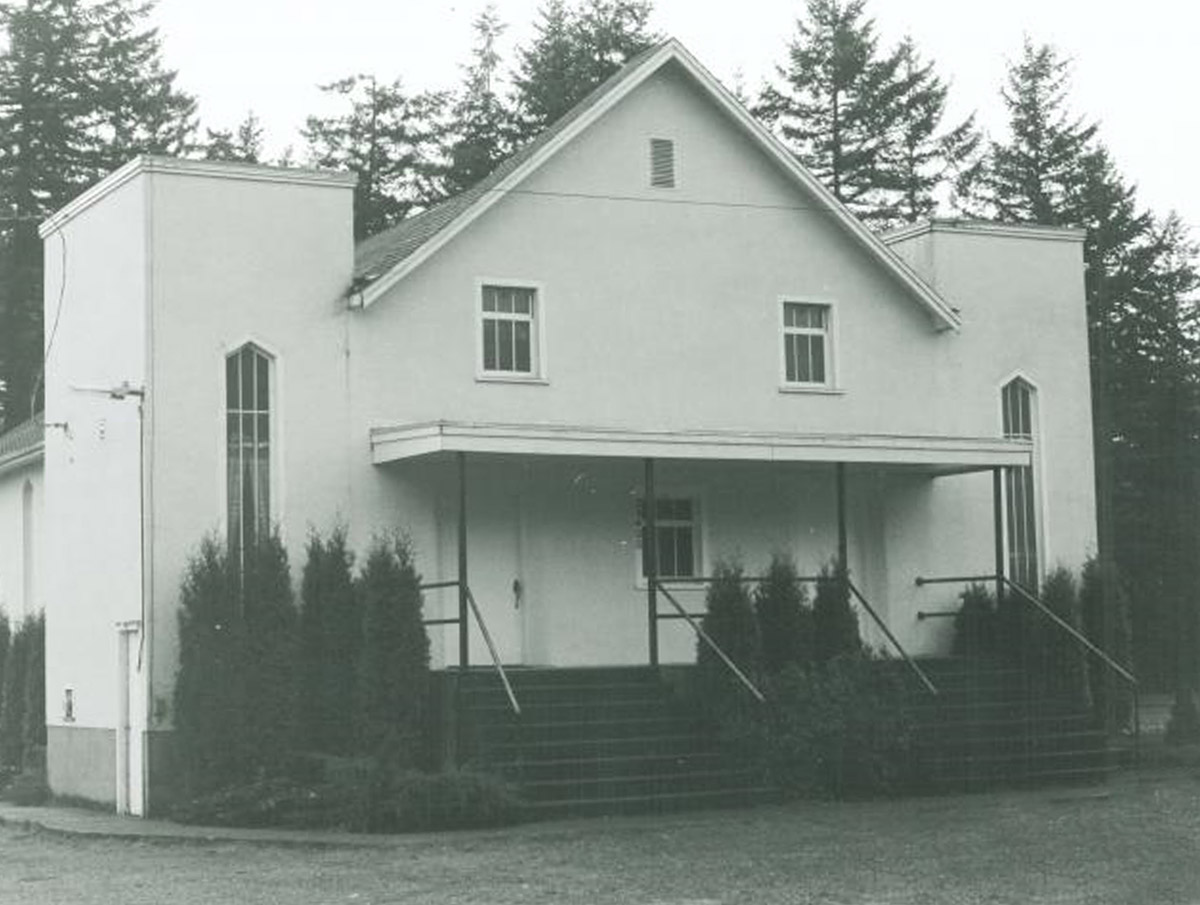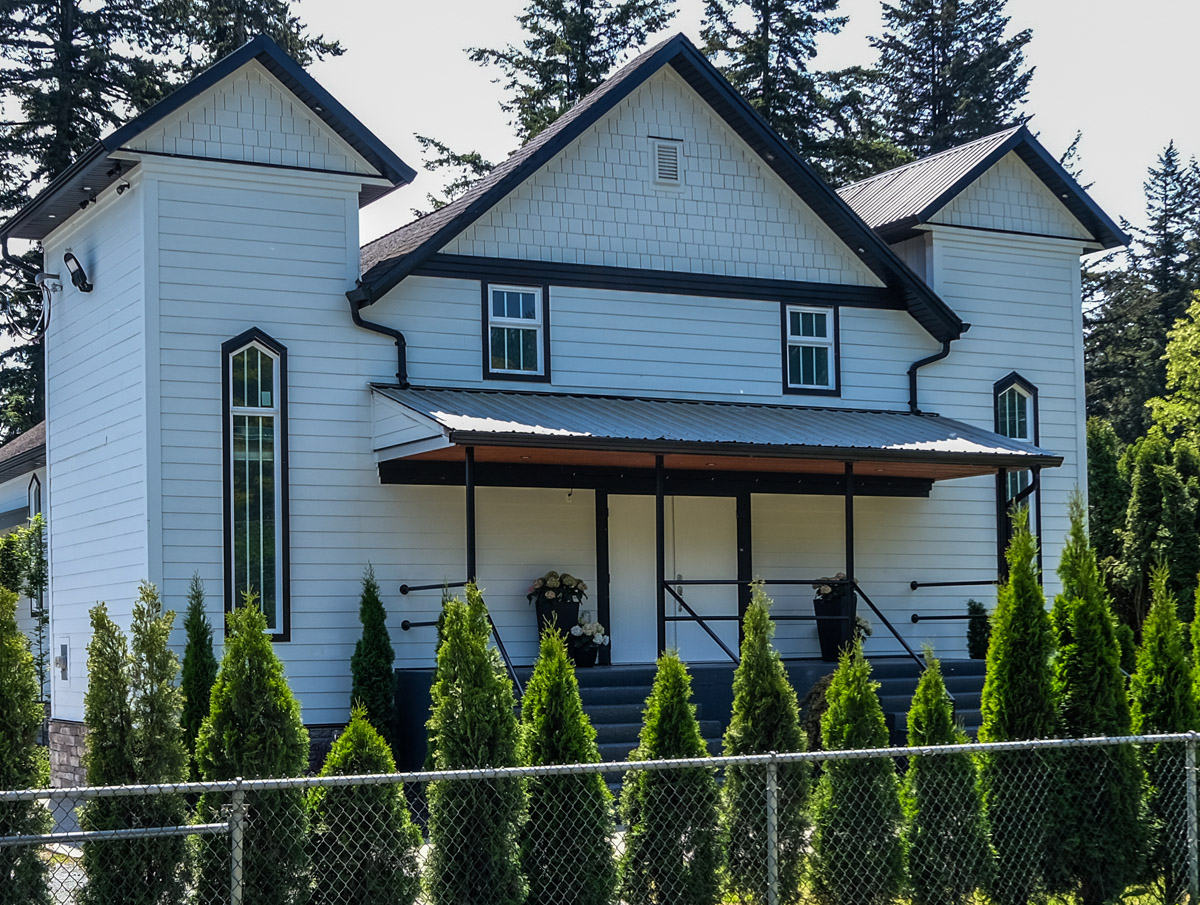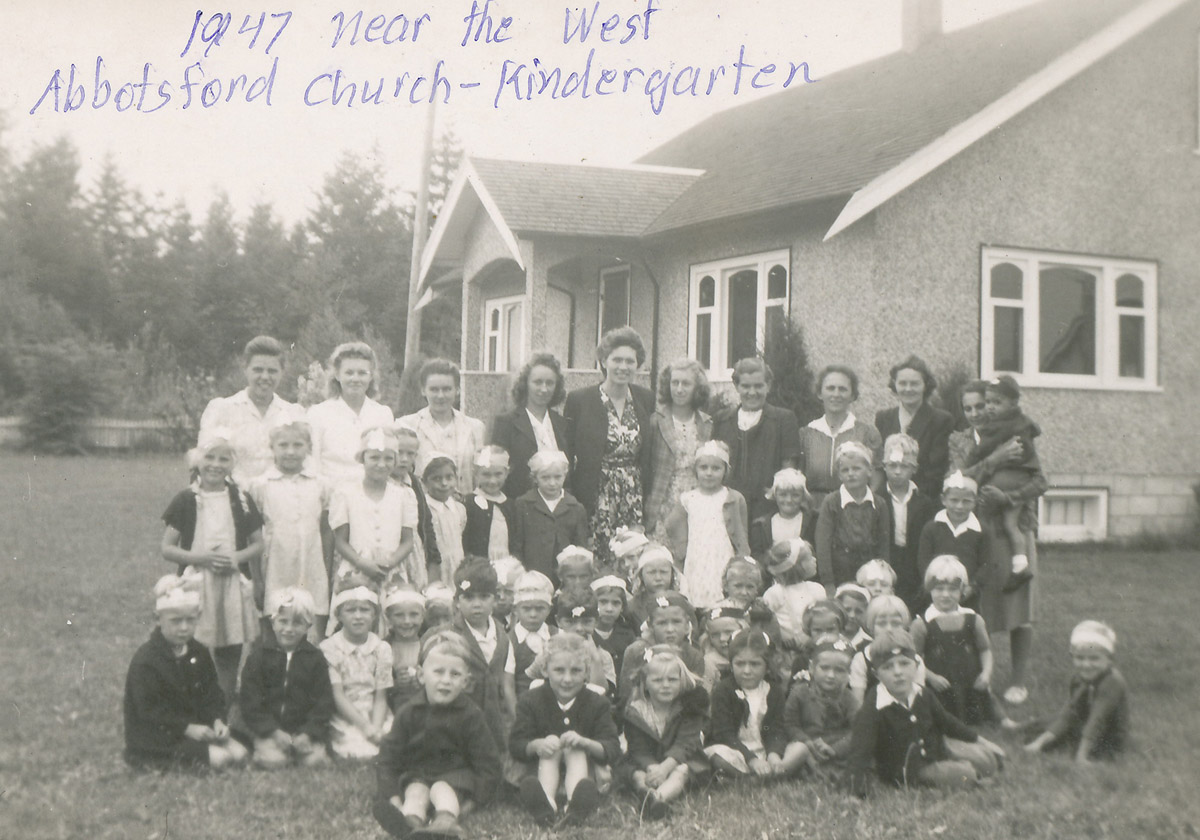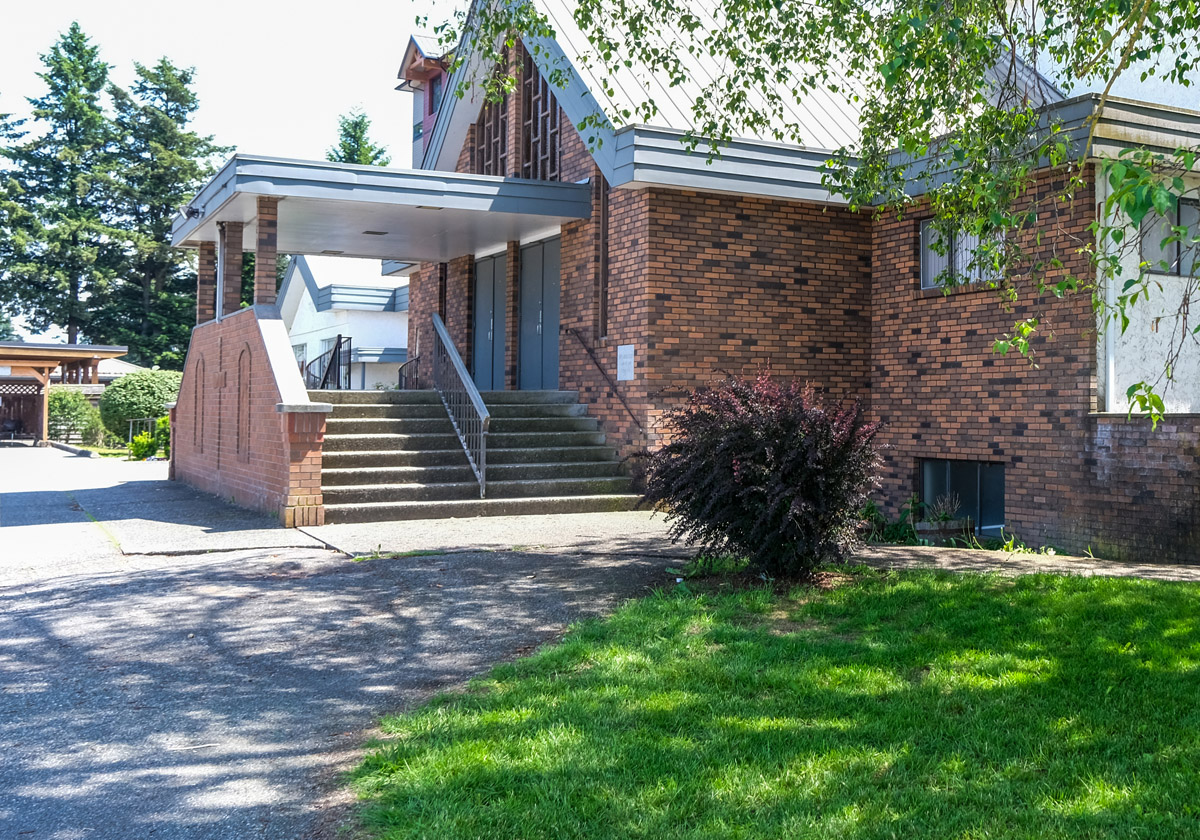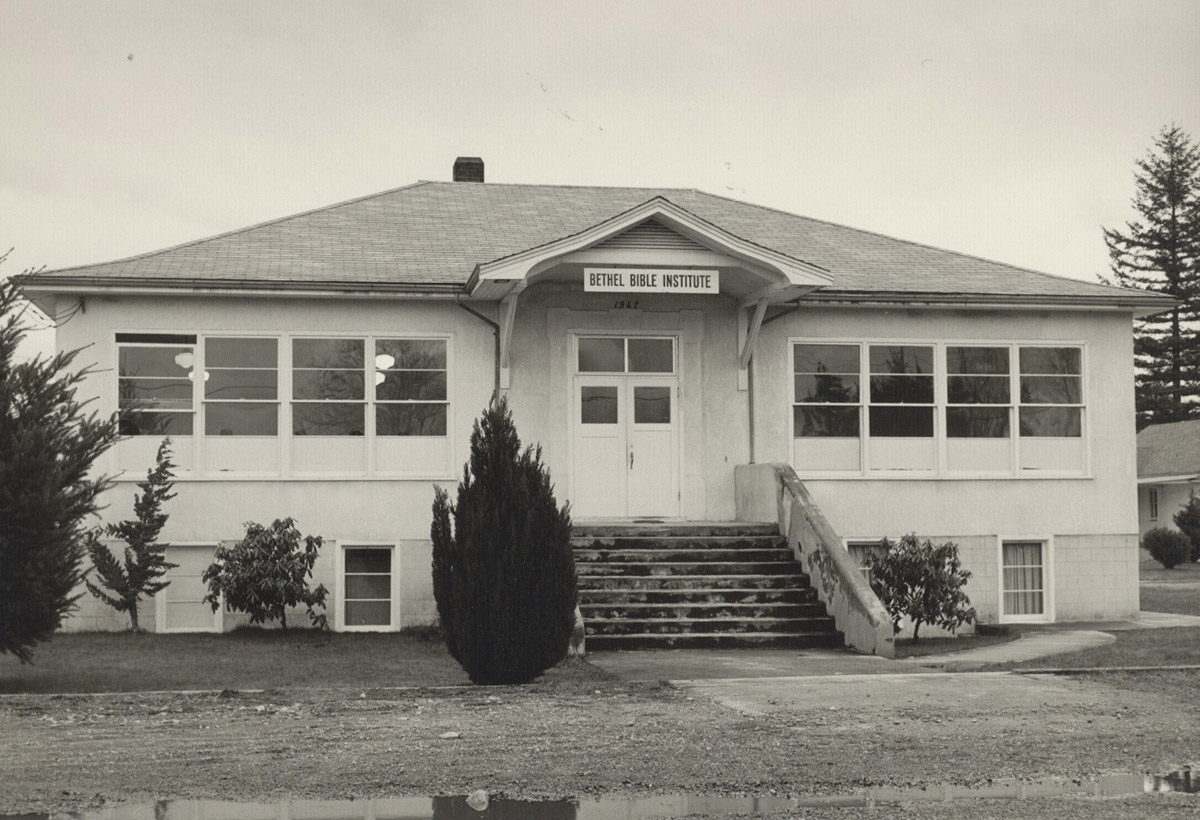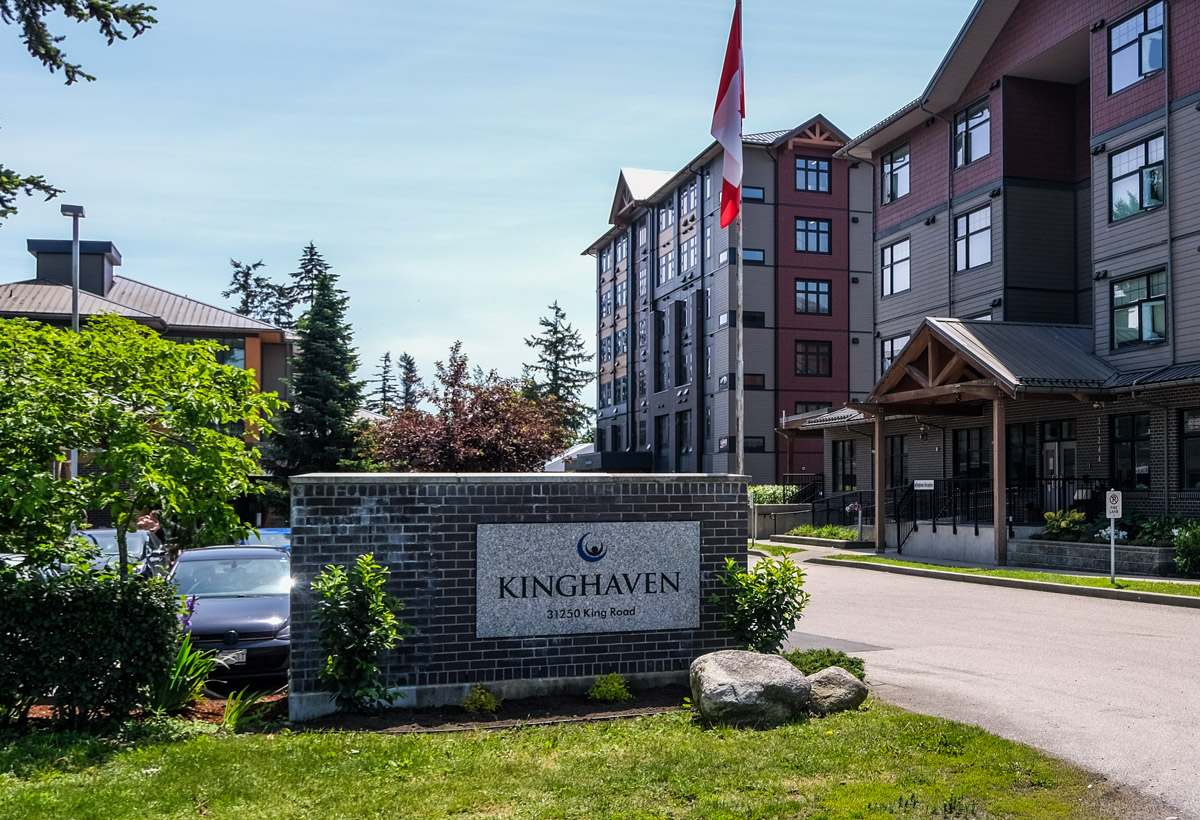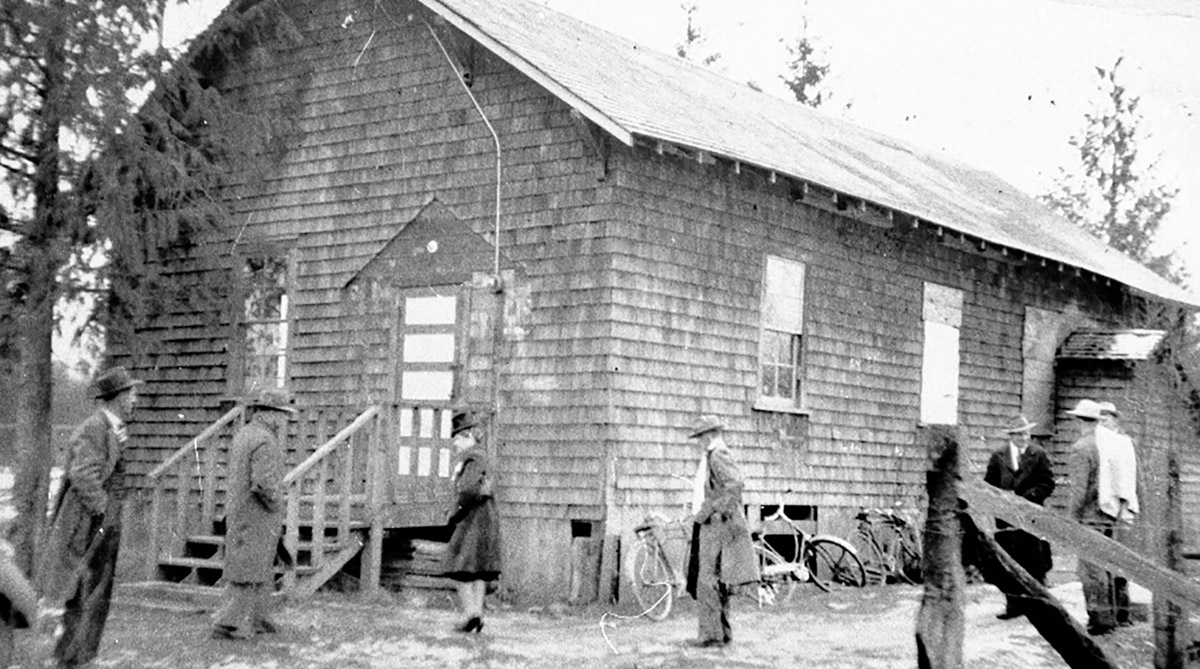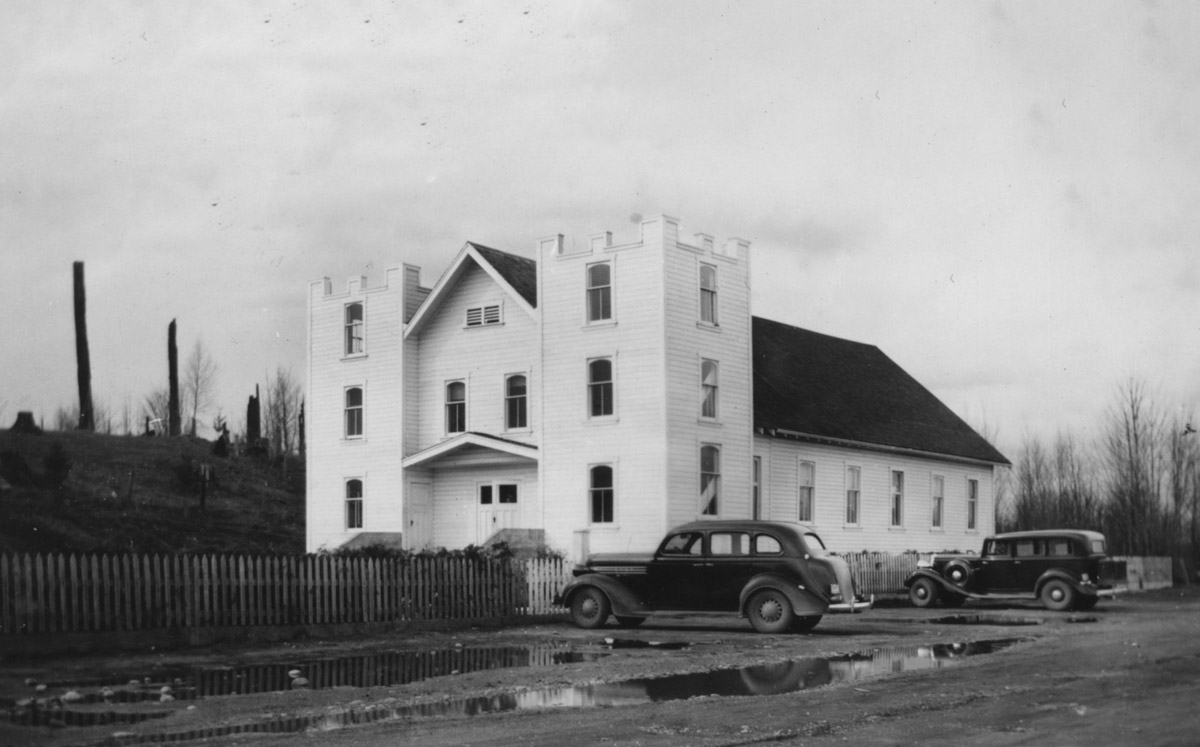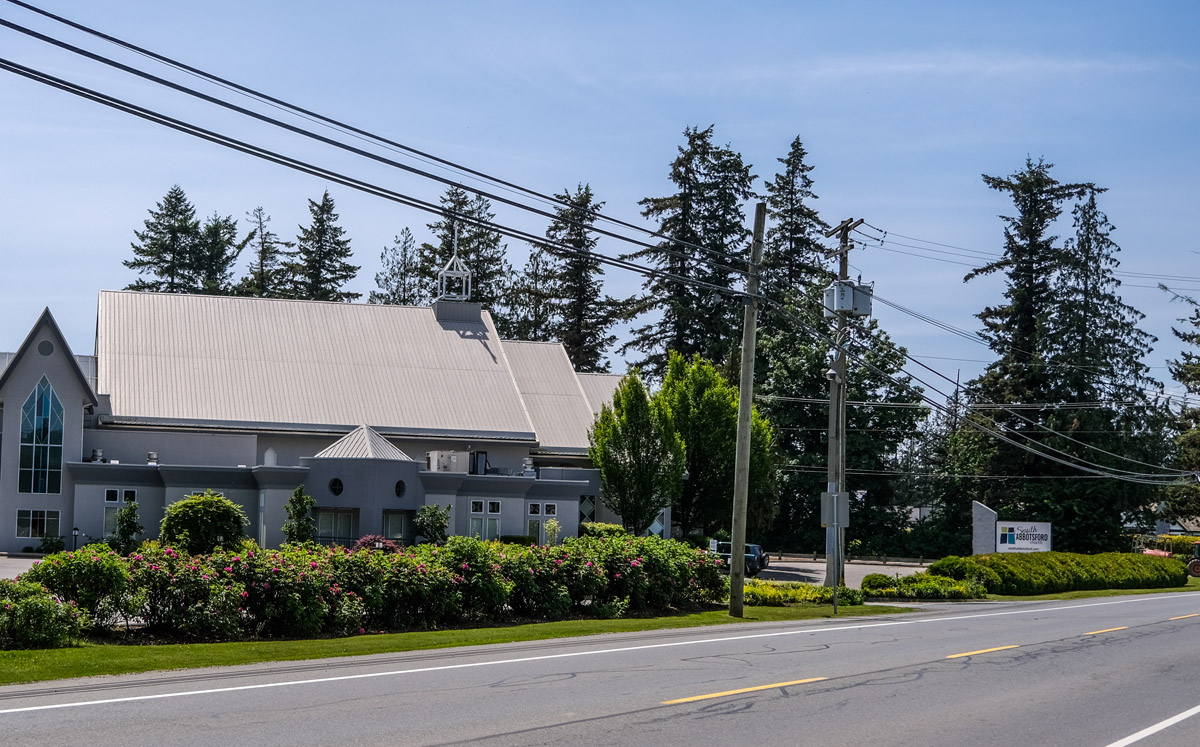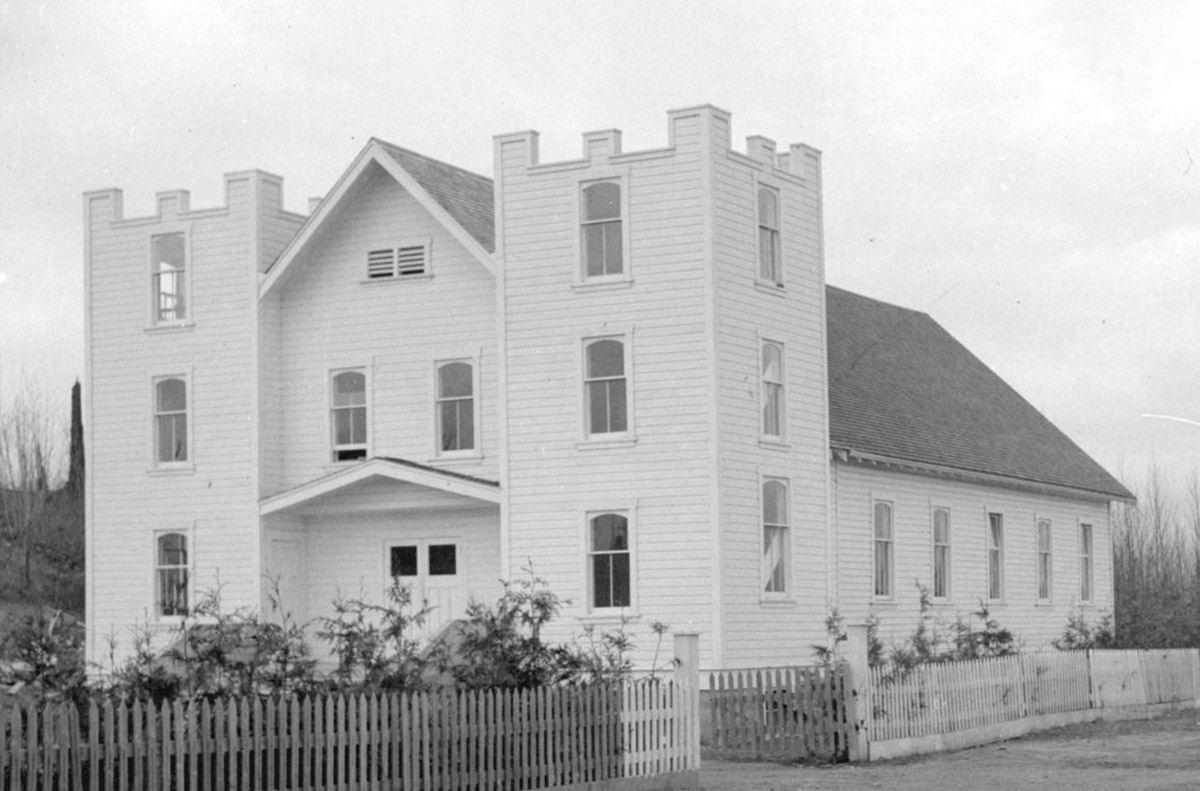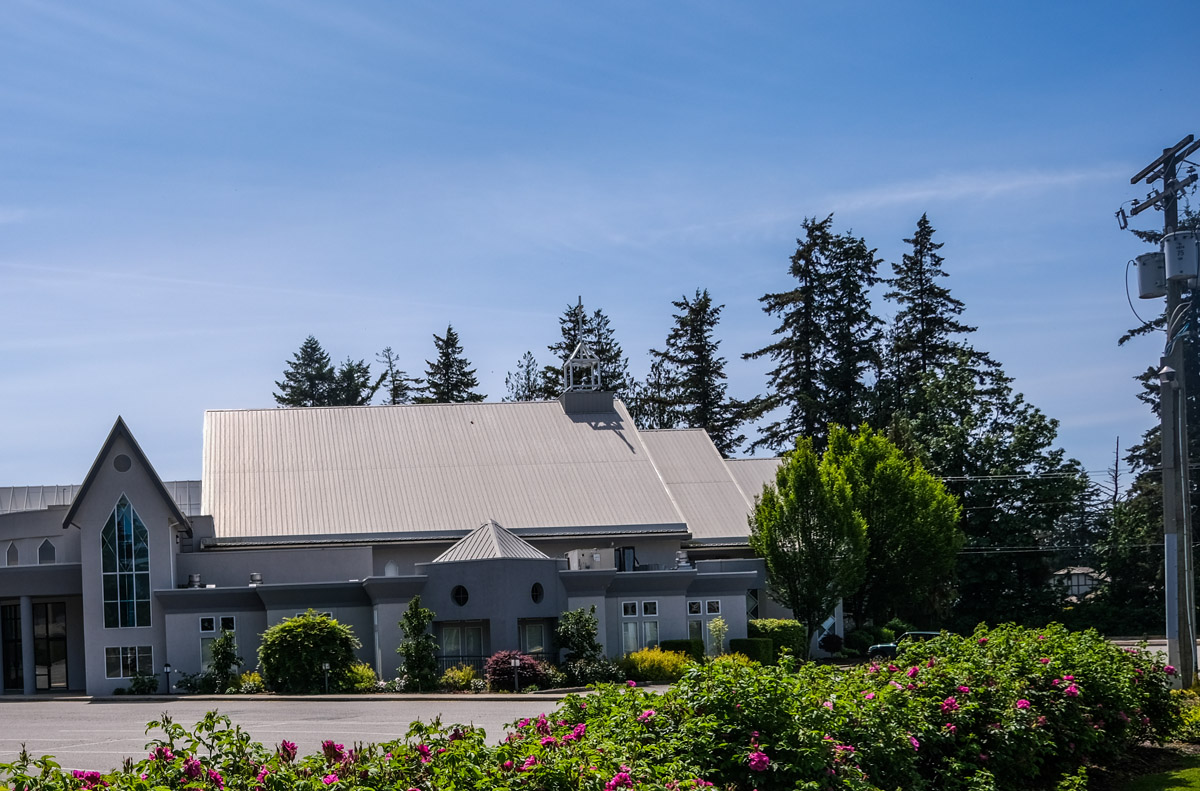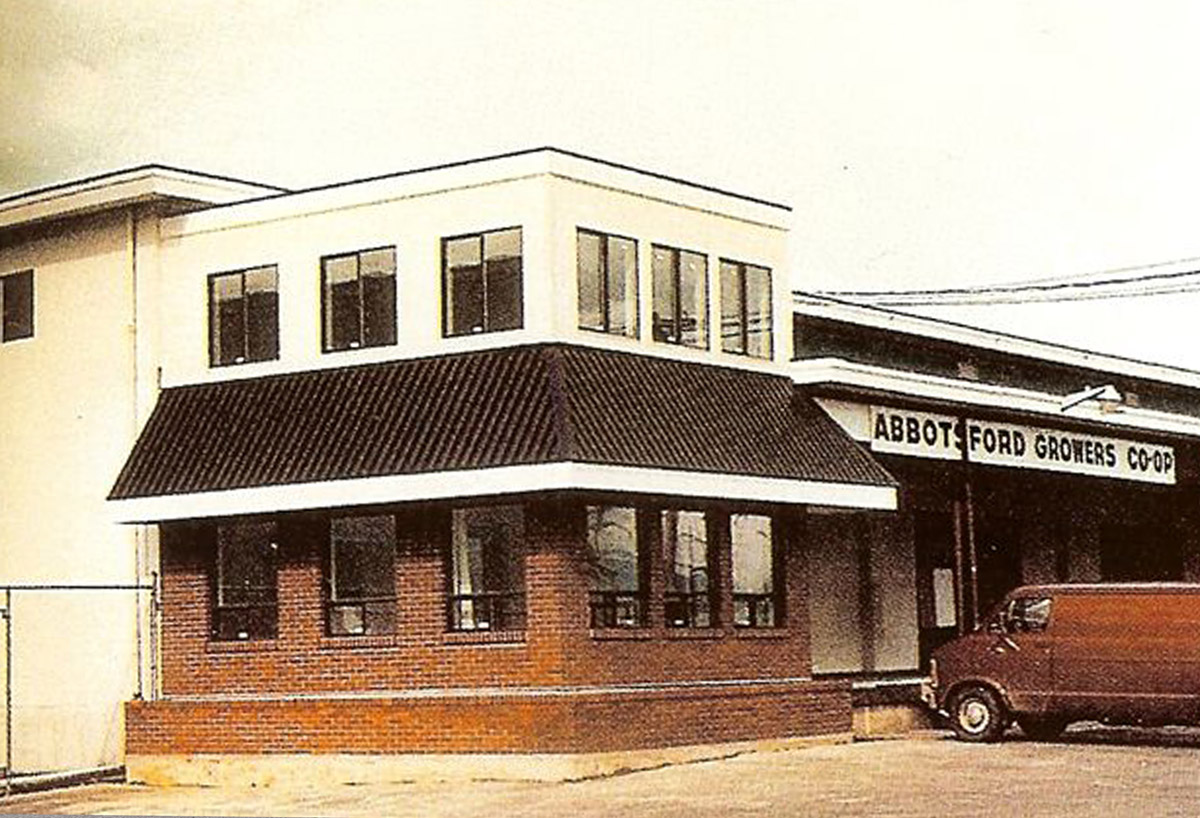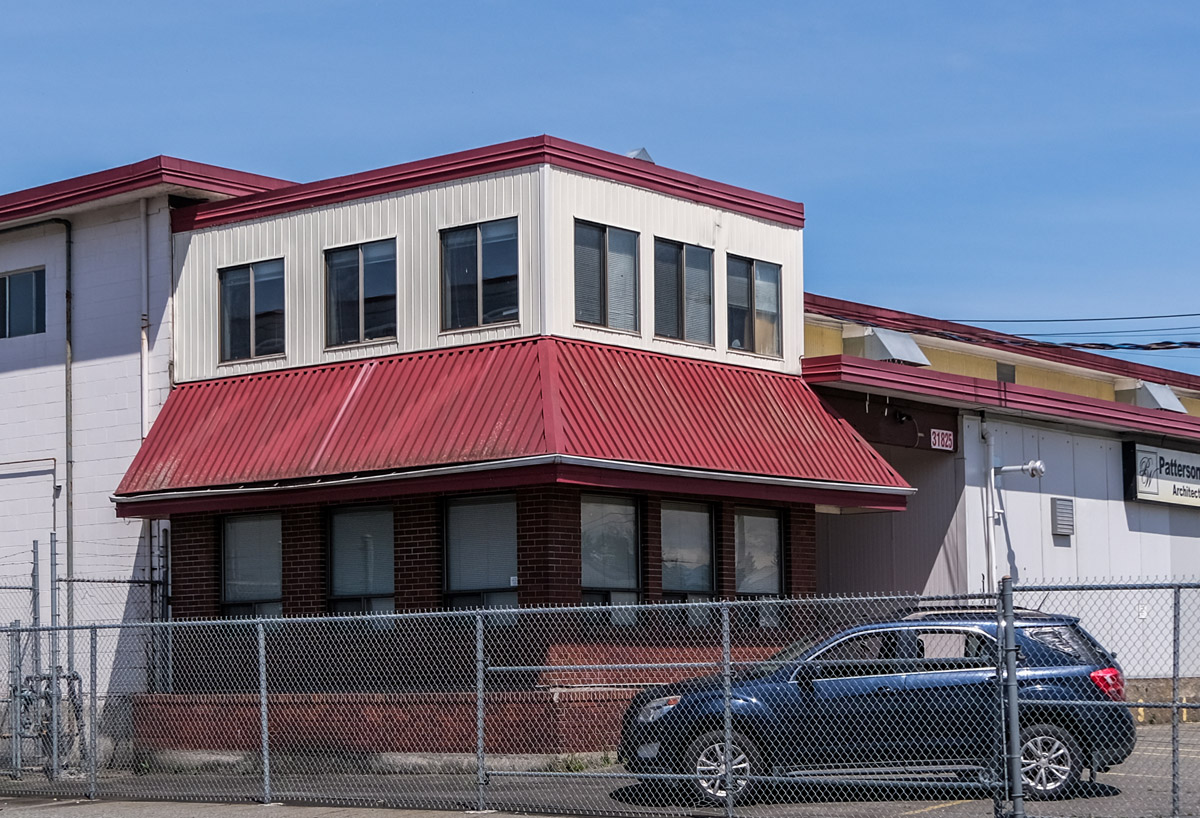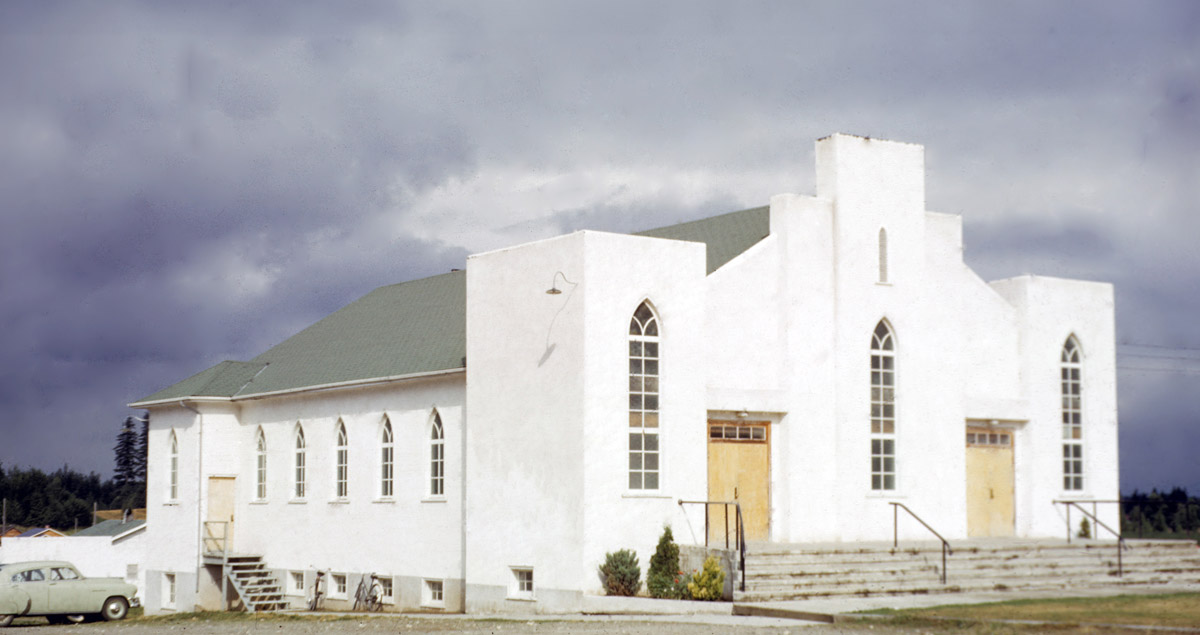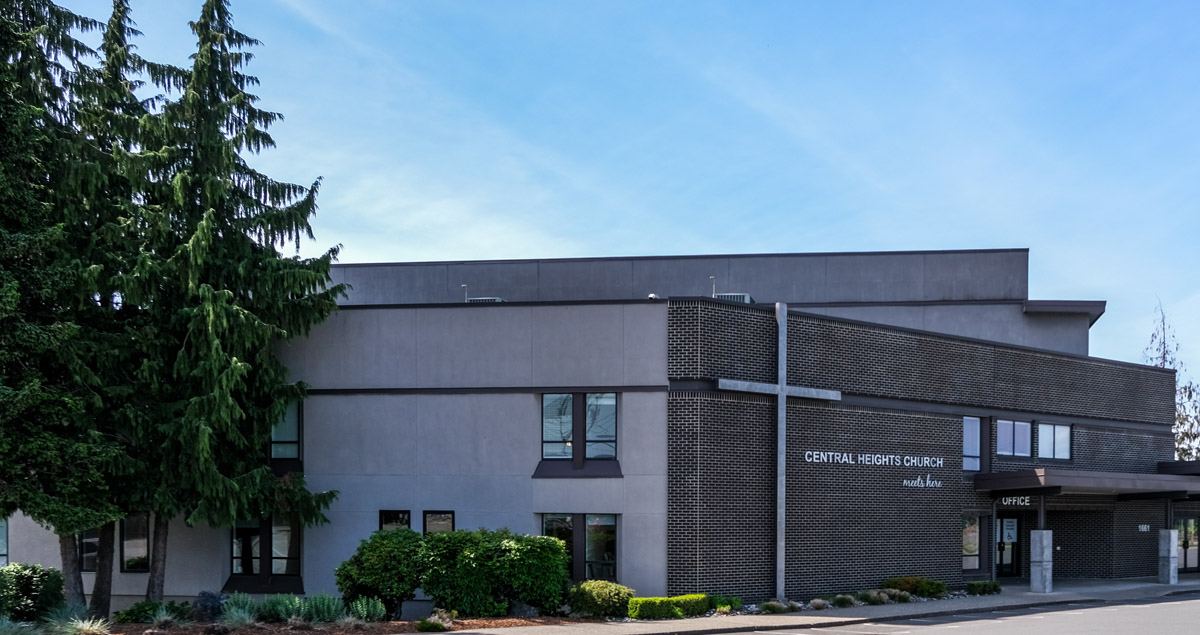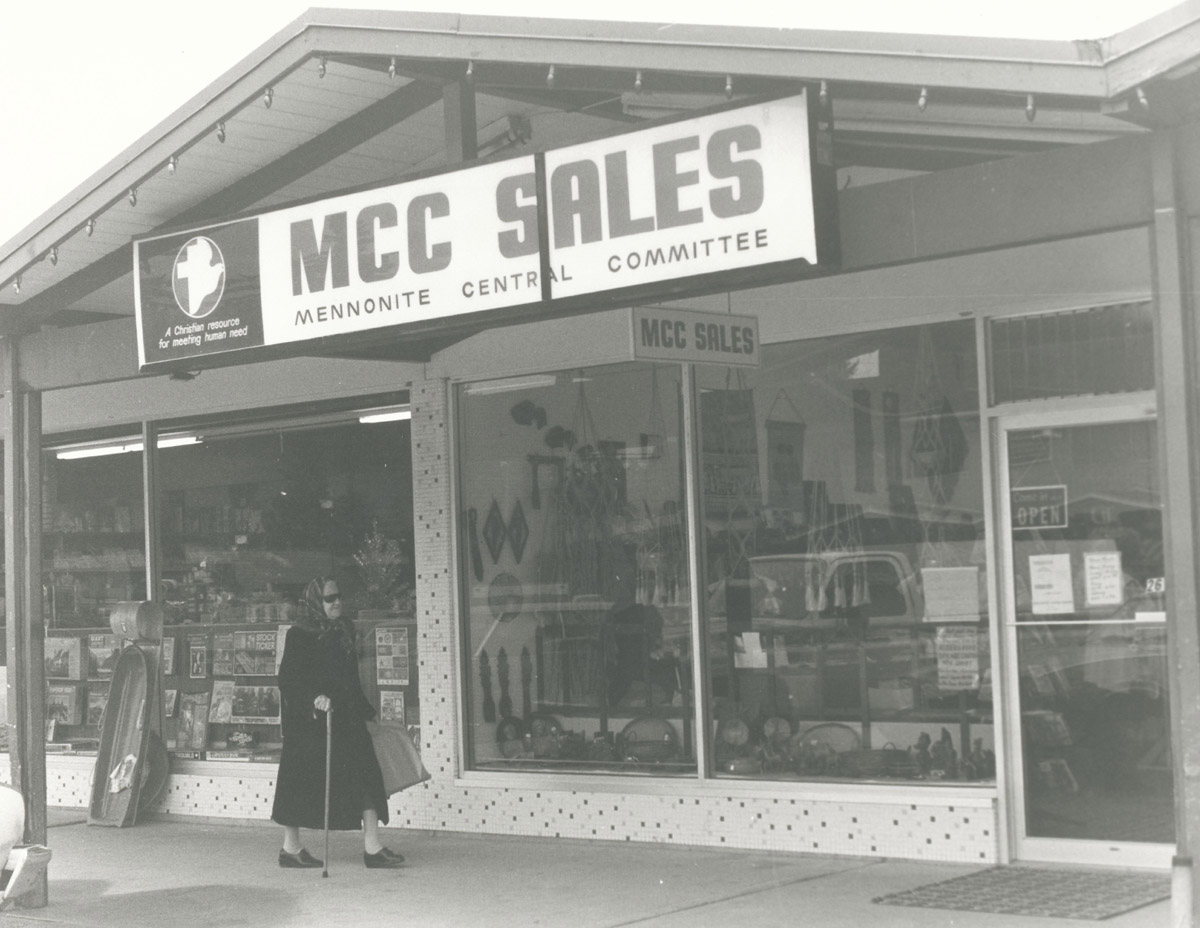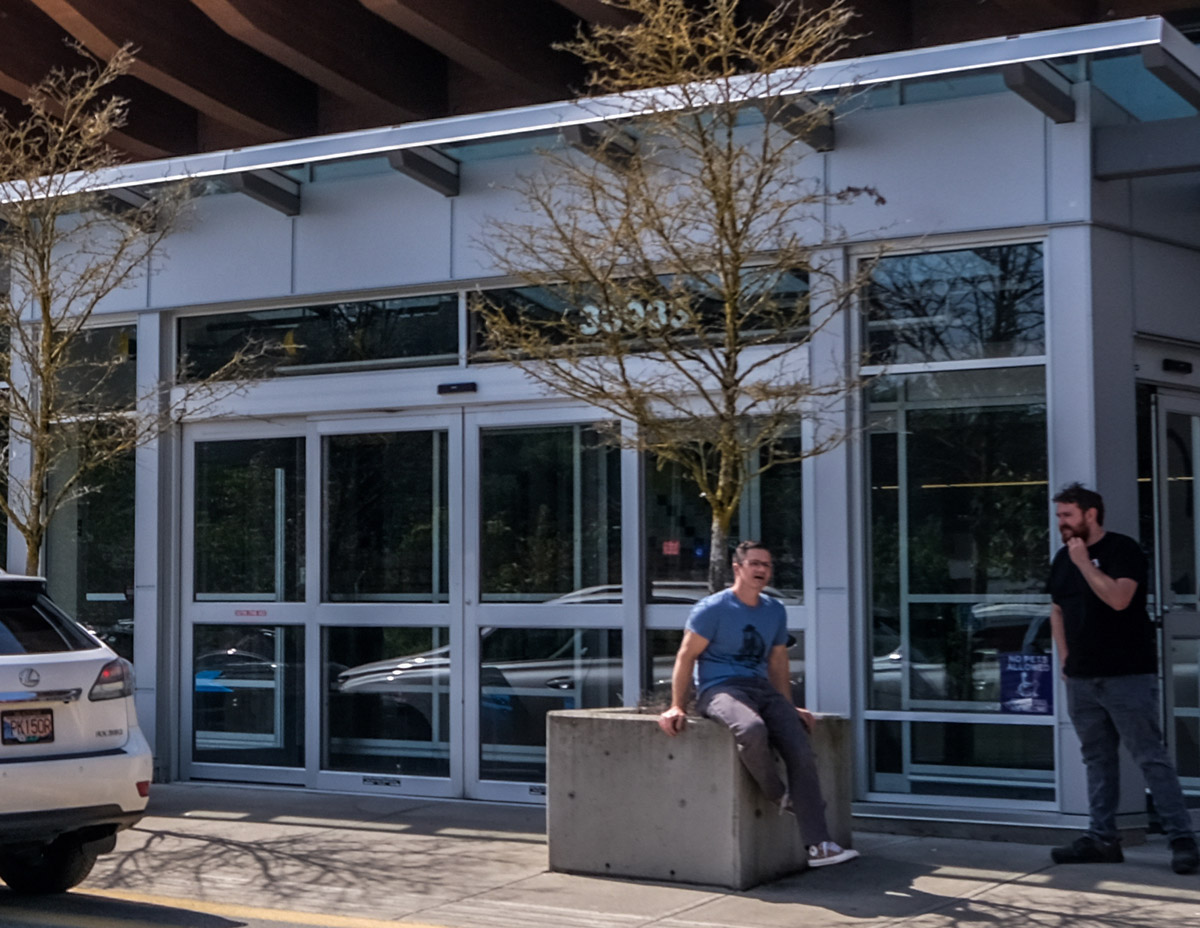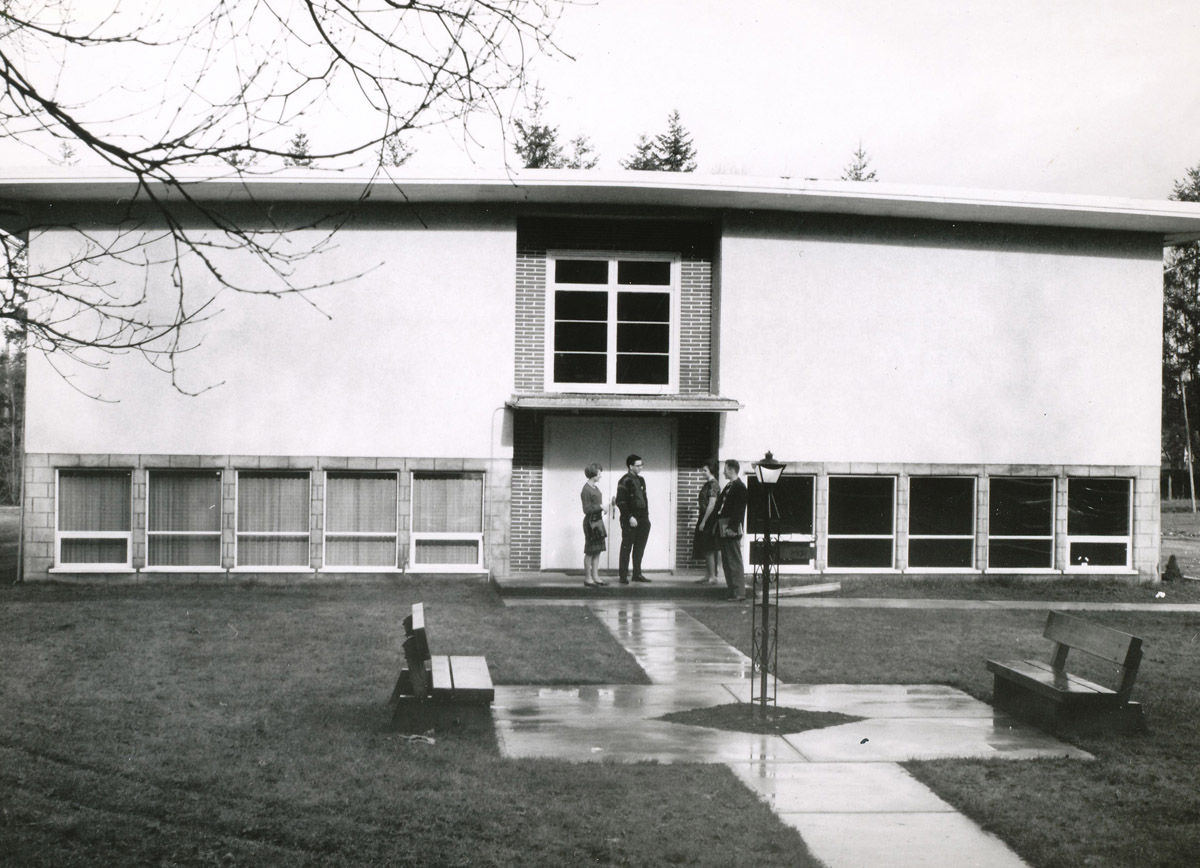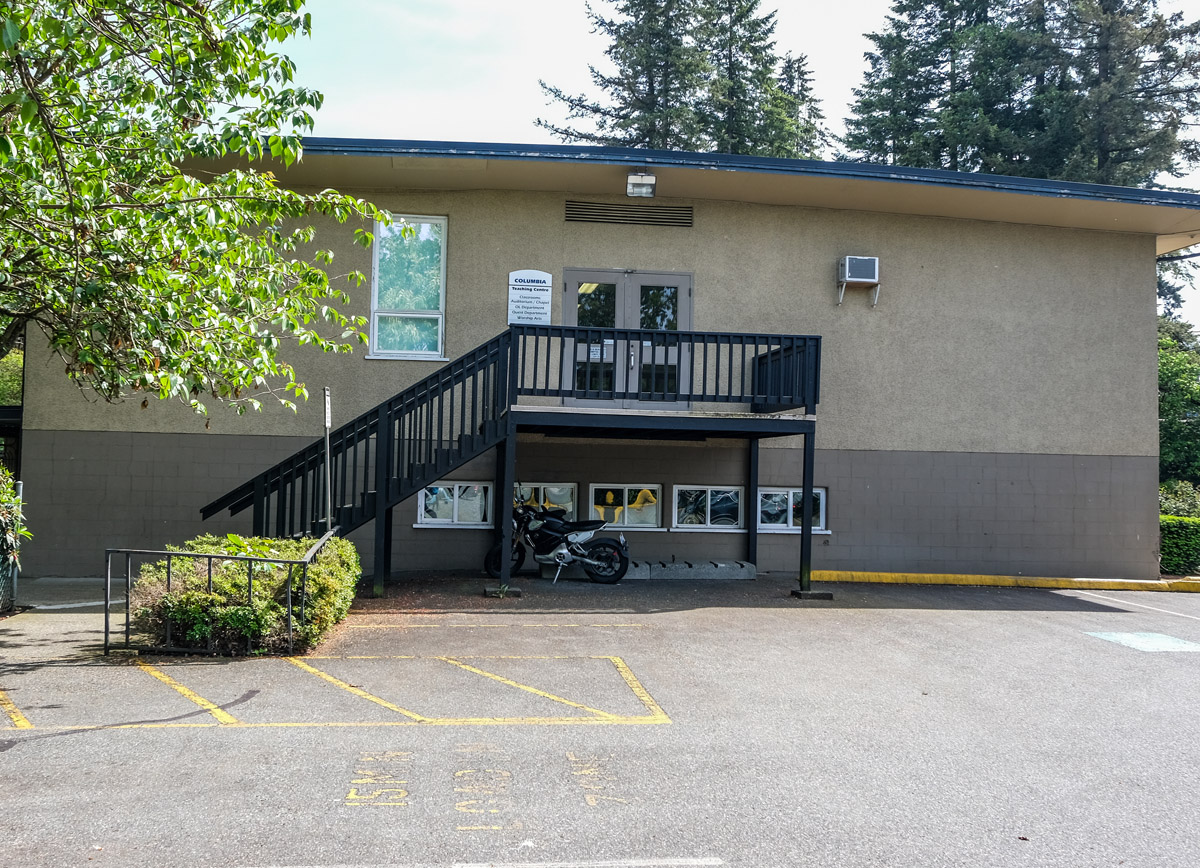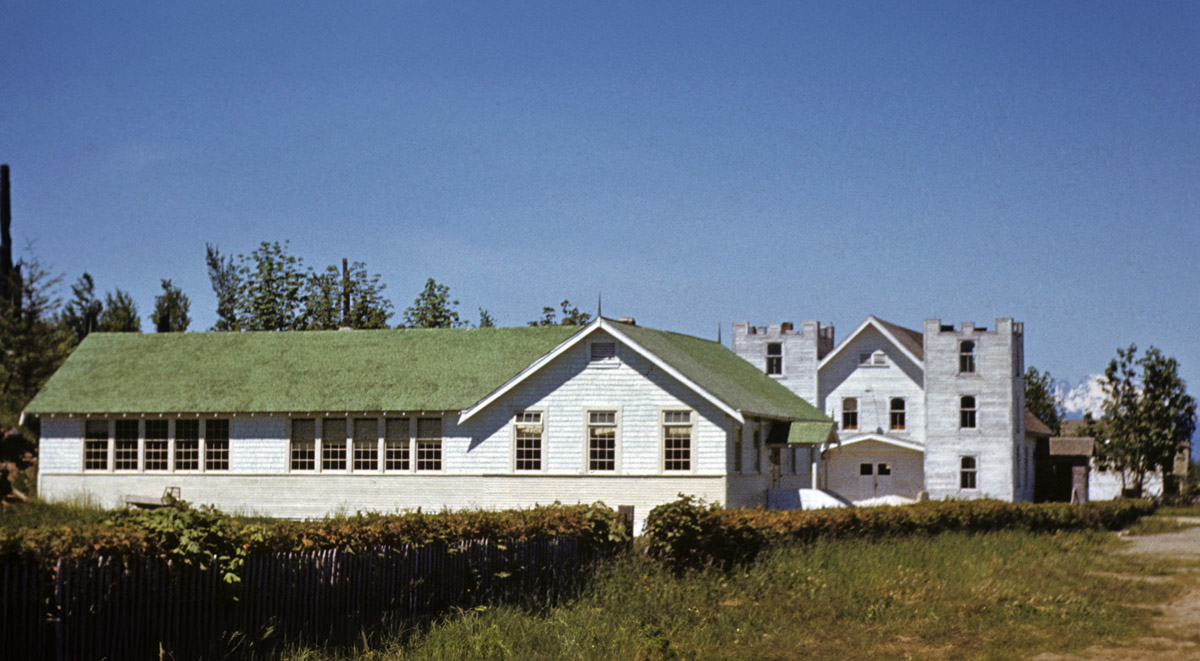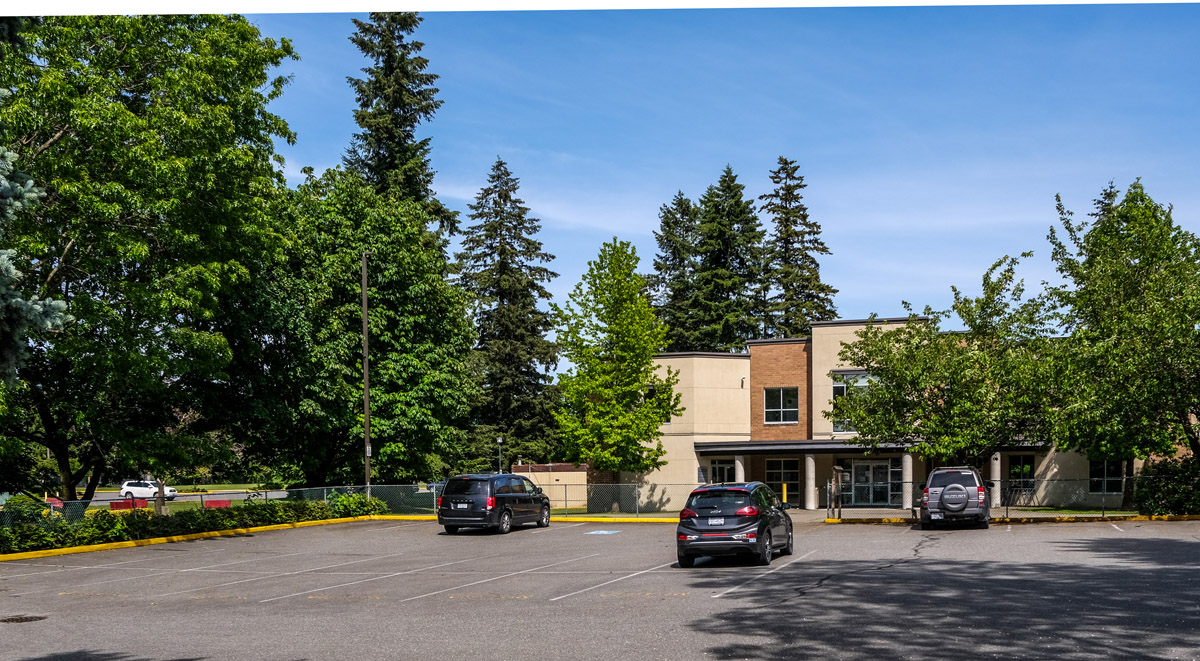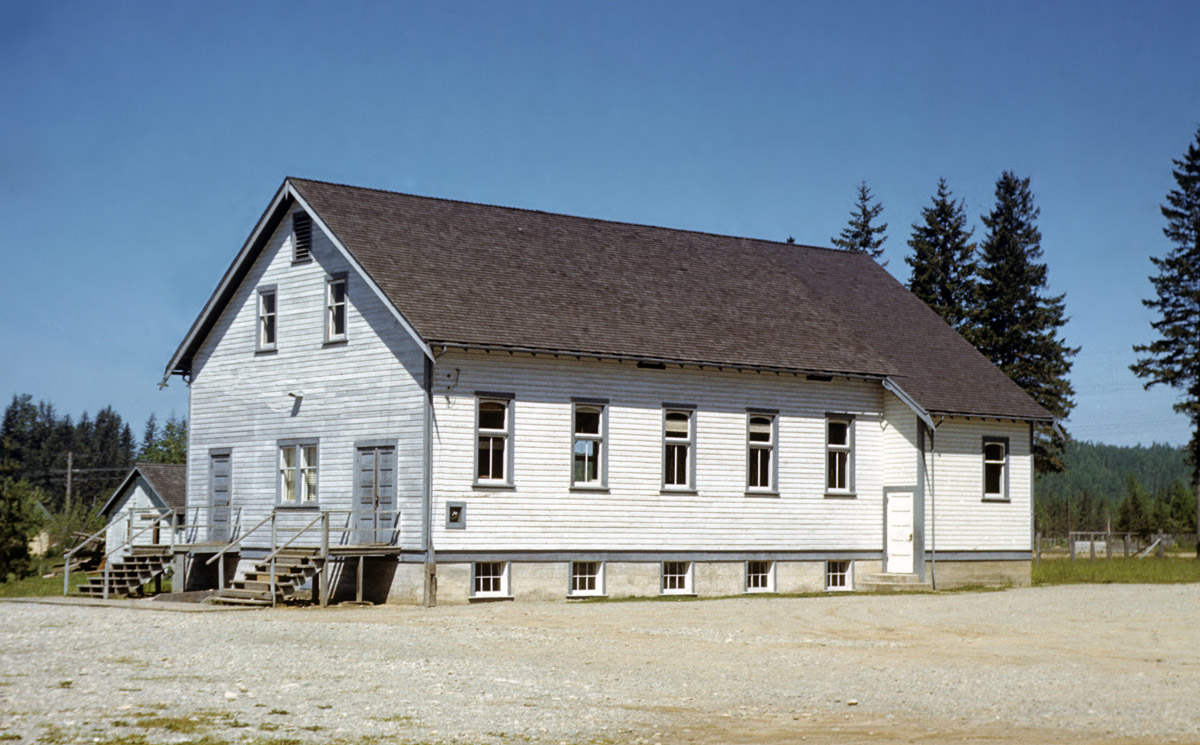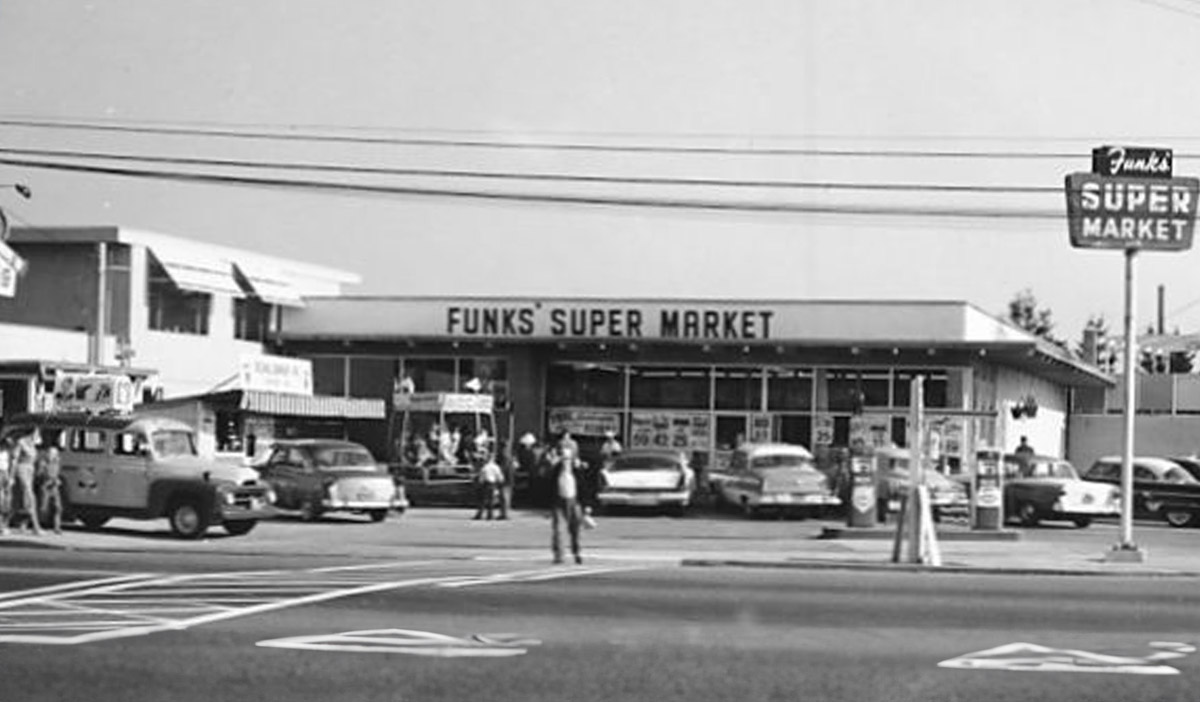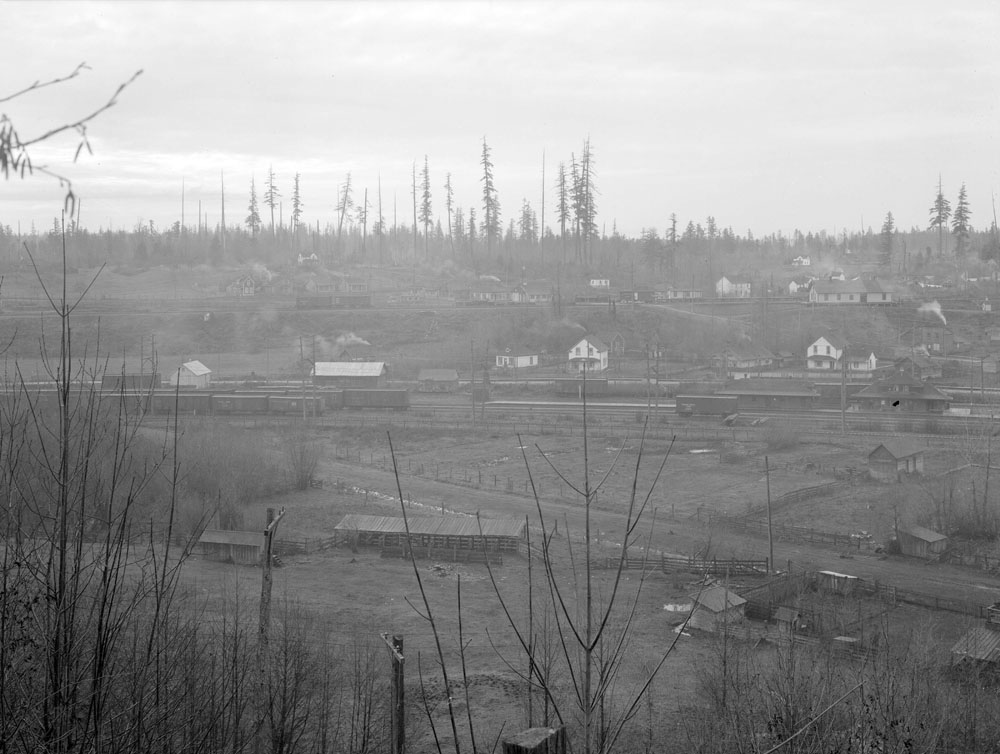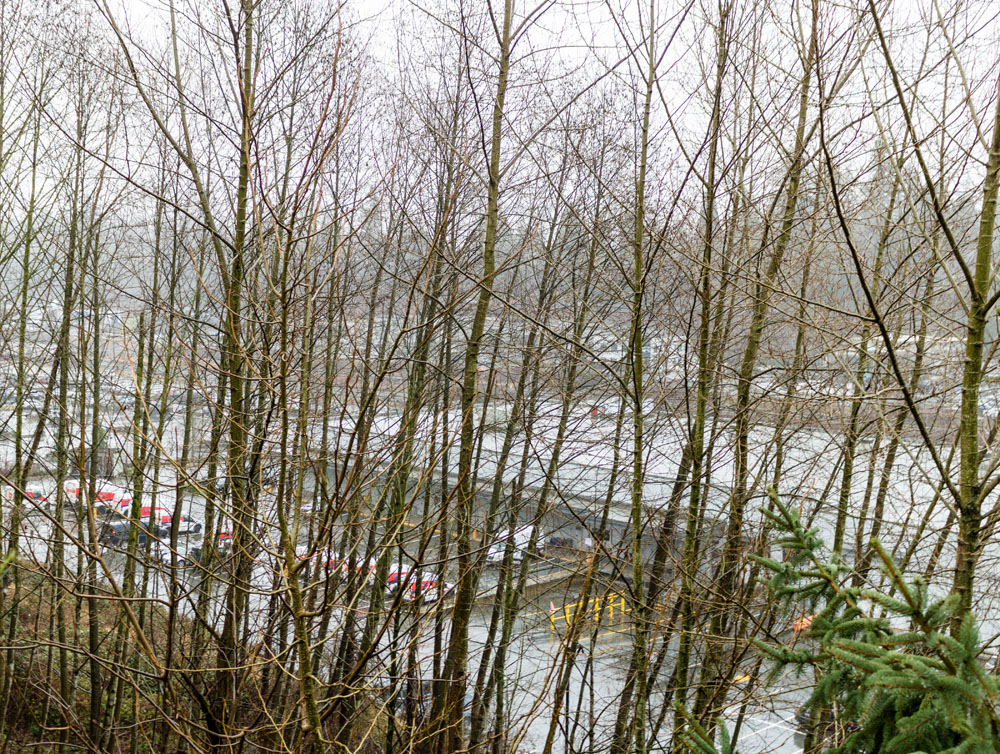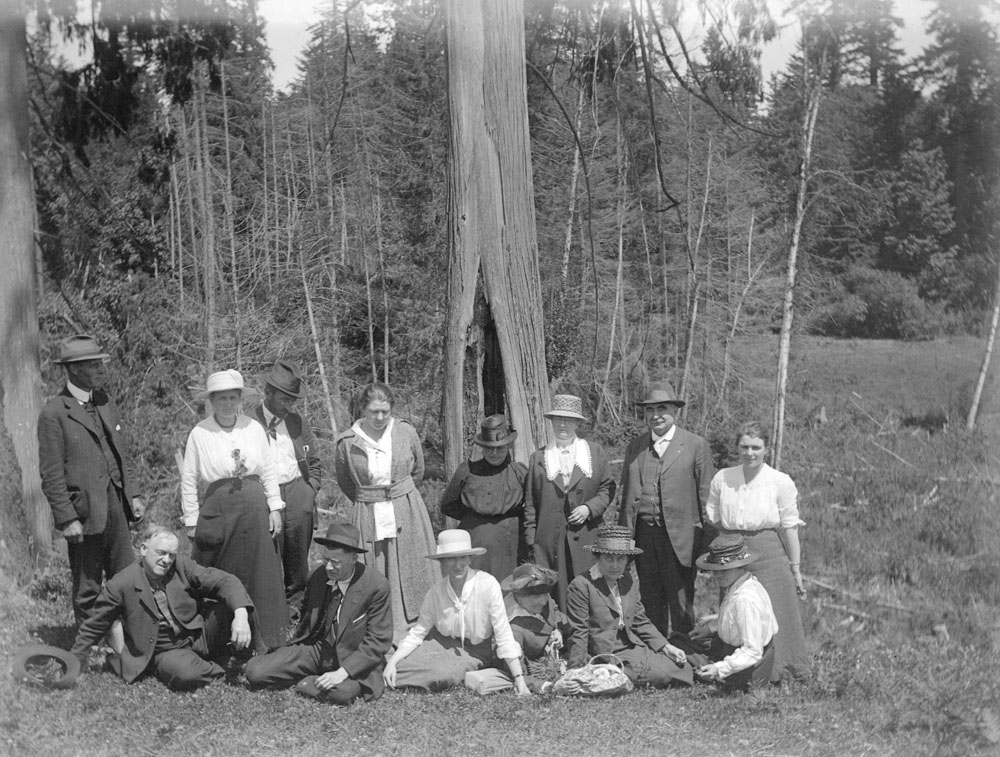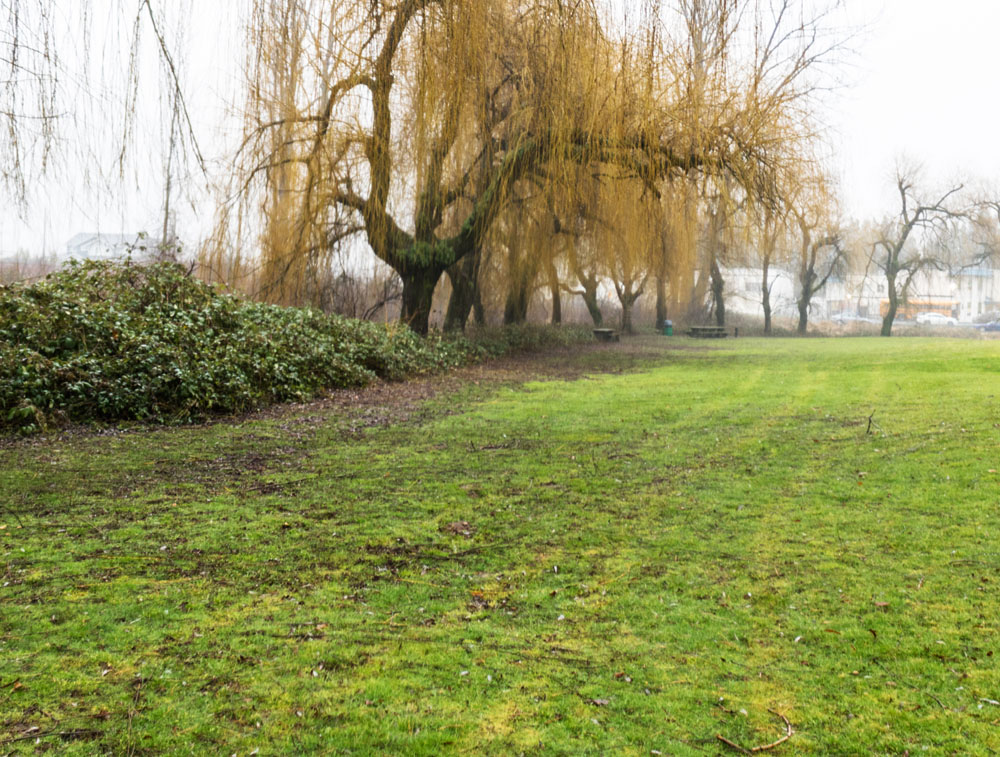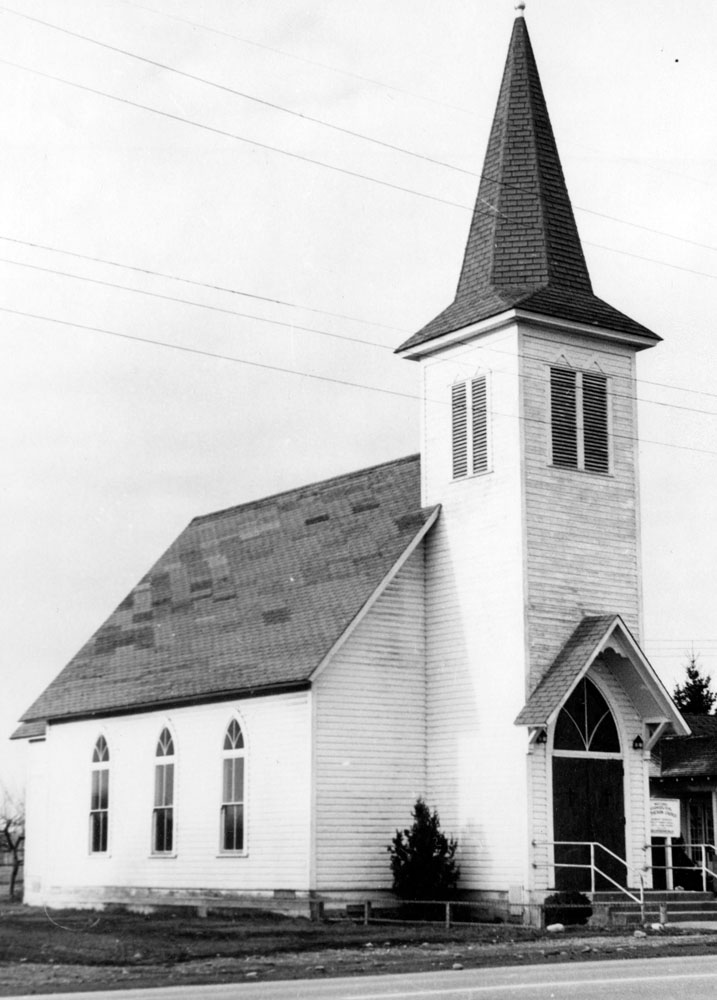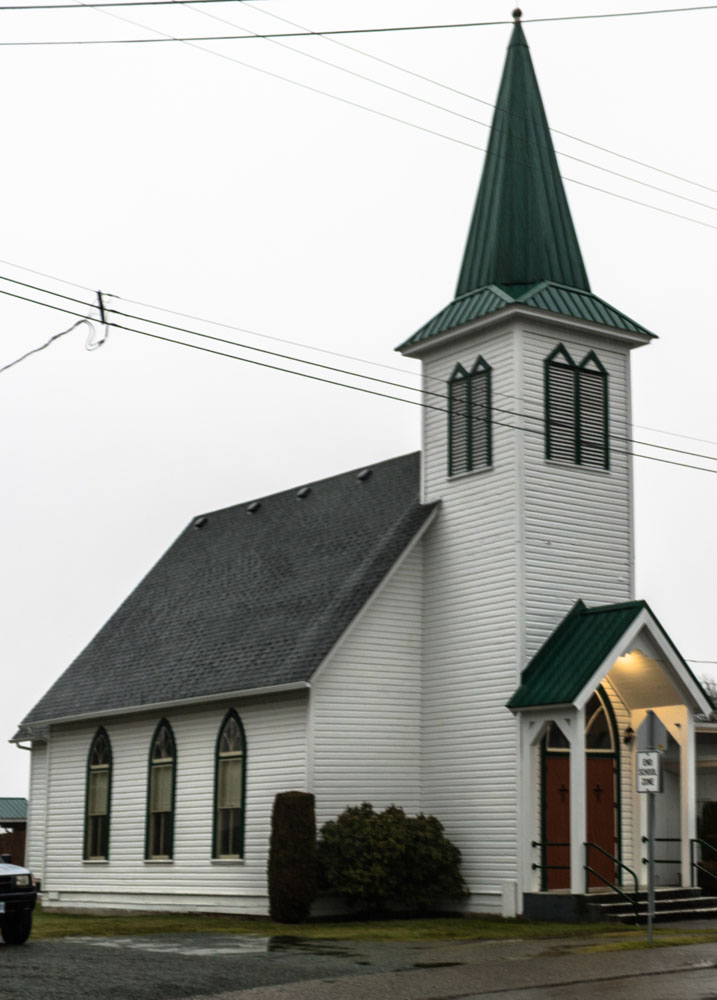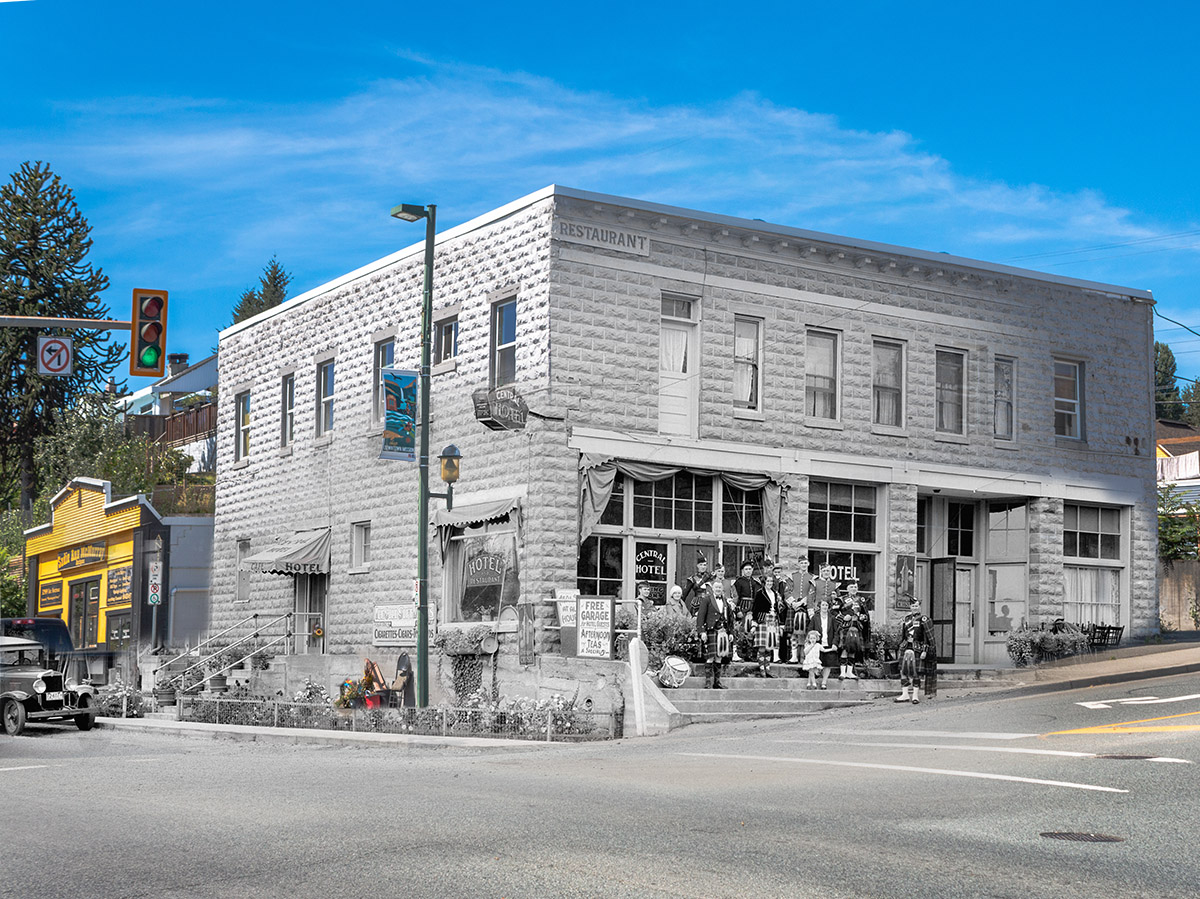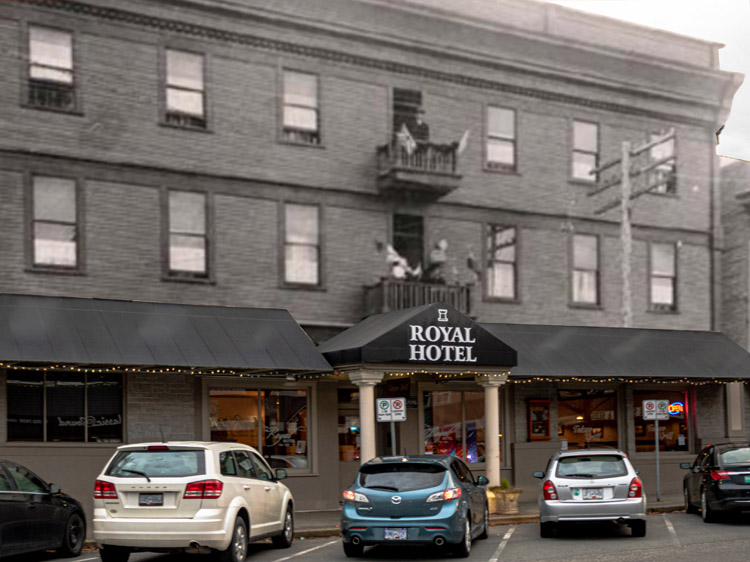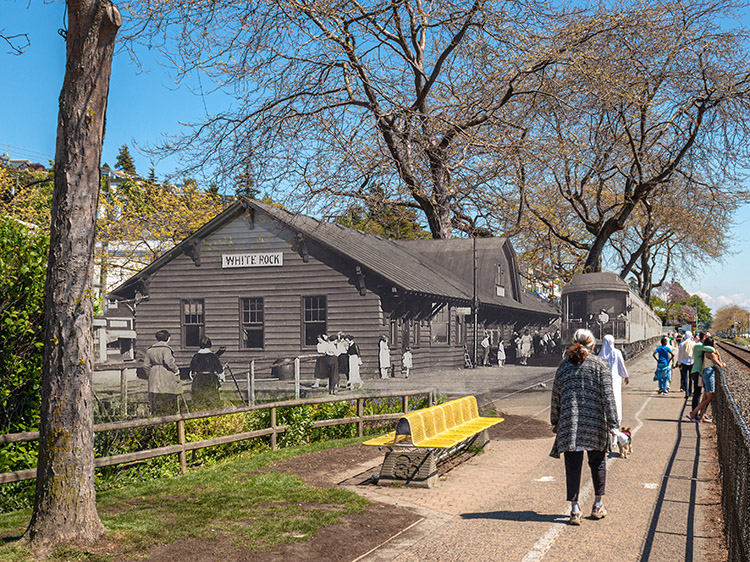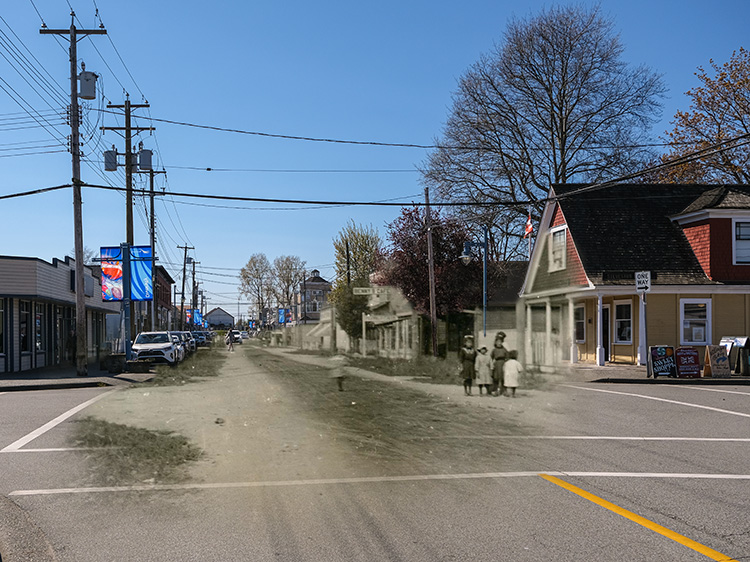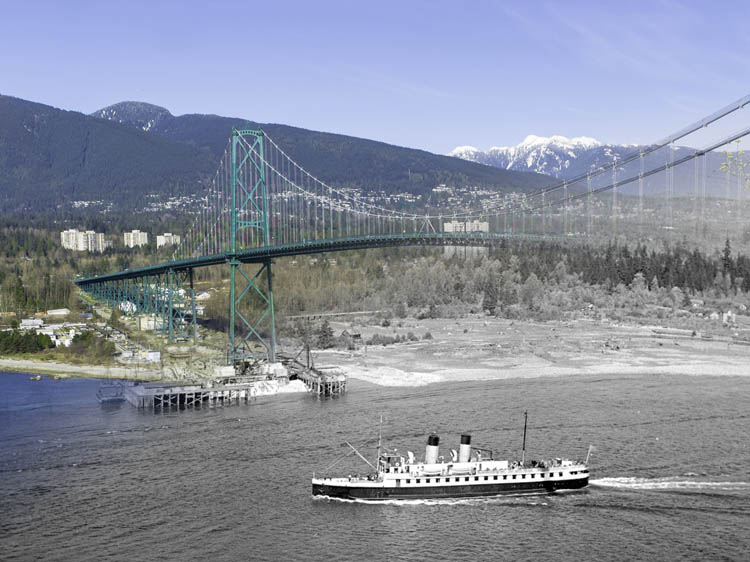Partner City
Abbotsford
Handmade and Homegrown
Abbotsford is a sprawling municipality on the banks of the Fraser River. Home to the Sto:lo First Nation for thousands of years, the historic downtown was first laid out by European settlers in 1891 alongside the Old Yale Road, a track used by gold-seekers to reach the Interior. Abbotsford has since grown into a large city, with many industries, rich farmland, and a young population. Abbotsford is made up of a number of different communities outside the historic downtown, notably Matsqui Village, a Scandinavian farming settlement that is featured in one of our walking tours.
This project is a partnership with Heritage Abbotsford and we owe them generous thanks for their support. This project was funded in party by the Heritage BC Legacy Fund.
We would like to acknowledge that the land on which all this content is built is the traditional and unceded territory of the Stó:lō.
Virtual Tours
Tours
Explore
Abbotsford
Stories
Matsqui Mennonite Brethren Church
Mennonite Story
Matsqui Mennonite Brethren Church was founded in 1945. After starting in a converted farmhouse, its congregation worshiped in a sanctuary, which sadly burned down in 1959. A new church was constructed, but declining membership due to changing demographics led to its dissolution in 1975.
* * *
Matsqui Mennonite Brethren Church was established in 1945 in Matsqui village, initially meeting in a converted farmhouse. With Abram D. Rempel as the founding leader, the congregation started with 71 members who had separated from the South Abbotsford Mennonite Brethren due to distance. Construction of a dedicated sanctuary began in 1947 but was interrupted by the 1948 flood. During that time, the congregation temporarily met at the Abbotsford airport. The sanctuary was eventually completed in 1950 and dedicated in March of that year. In 1959, the church building burned down, leading to the construction of a new church that was finished in 1960.
Membership in the church grew from 71 to a peak of 200 in 1955, eventually settling at 117 by 1975. The church actively engaged in Christian education and outreach to the surrounding area, establishing Sunday school in Matsqui and constructing chapels in Silverdale and McConnell Creek. However, as the congregation aged, older members retired and sold their dairy farms, while younger generations chose urban living and work. As a result, the church decided to dissolve on September 23, 1975, and the building was sold to a Baptist congregation.
Mennonite Education Institute
Mennonite Story
The Mennonite Educational Institute (MEI) began in 1944 to provide education aligned with Mennonite faith and values. Local leaders recognized the need for a school that preserved the Mennonite culture, language, and offered quality education. With support from Mennonite Brethren and General Conference Mennonite Churches, seven churches endorsed the school. To obtain government approval, representatives were elected to negotiate conditions, including no financial support, qualified teachers, and English as the primary language. Despite building restrictions during the war, MEI started with an addition to South Abbotsford Mennonite Brethren Bible School. The initial enrollment of 60 students decreased due to conscription, but MEI remained committed to providing education rooted in Mennonite values and cultural preservation, even in challenging circumstances.
* * *
Local leaders recognized the need to provide education for young Mennonites that aligned with their faith and values, as they were concerned that existing institutions did not fully uphold these principles. The School Committee, in its early minutes, outlined three main purposes for establishing the school: preserving the Mennonite faith and culture, maintaining the German language, and providing quality education. The support of Mennonite Brethren (MB) and General Conference Mennonite Churches in the Fraser Valley was sought, and seven churches decided to endorse the school.
To obtain government approval, three individuals—Cornelius Toews, George Sukkau, and Alex Bauman—were elected to represent the school in Victoria. Dr. Willis, the Deputy Minister of Education, laid out three conditions for granting permission: no financial support from the government, qualified teachers must be hired, and English must be used as the primary language of instruction. With these conditions agreed upon, the decision was made to move forward with establishing the school.
Due to the restrictions on obtaining building permits during the war years, the initial plan was to construct an addition to the existing South Abbotsford Mennonite Brethren Bible School to accommodate the first batch of students. The chosen location was at the intersection of Huntington and Gladwin Roads, an area where many Mennonite families had recently settled. Franz C. Thiessen, formerly from Winnipeg, took on the role of principal and teacher, while Isaak J. Dyck from Winkler, Manitoba, was hired as another teacher. Henry H. Nikkel was later added to the teaching staff, as the enrollment of 60 students surpassed expectations. However, conscription reduced the student total to 44, making it challenging for the $80.00 per student tuition to cover the salaries, despite the teachers receiving significantly lower pay compared to the local school district.
Thus, with determination and resourcefulness, MEI started its journey, providing education that reflected Mennonite values and fostering a sense of cultural preservation within the Mennonite community, even in the face of wartime limitations.
East Aldergrove Mennonite Brethren Church
Mennonite Story
In 1947, a group of brethren from North Abbotsford Mennonite Brethren Church established their own community church in Aldergrove, British Columbia. With limited resources, they purchased land and constructed a simple sanctuary. The congregation formally organized in 1947 and joined the British Columbia Conference of Mennonite Brethren Churches. The building underwent expansions and renovations over the years to accommodate the growing community. Services transitioned from German to bilingual and then exclusively English. In the mid-1980s, the church embraced contemporary music and changed its name to Ross Road Community Church in 2000. The church has been actively involved in church planting and had a membership of 379 individuals and an average attendance of 439 in 2010.
* * *
In the early days of 1947, a group of brethren from the North Abbotsford Mennonite Brethren Church gathered with a vision to establish their own community church. They were predominantly farmers residing in the Aldergrove and Mount Lehman areas, west of Abbotsford, British Columbia. Determined to have a place of worship in their own vicinity, they purchased five acres of land on the corner of Ross and Sinclair.
With limited financial resources but unwavering faith, they acquired the land for $1,500 and constructed a simple sanctuary in the form of a basement covered with roofing material. The building process, supervised by John Buehler, cost an additional $3,000. The modest space was equipped with a wood furnace for heating and basic benches for seating.
On June 13, 1947, with 93 charter members, the congregation formally organized as an independent entity. Worship services commenced on June 15 of the same year, and shortly afterward, in 1947, the church joined the British Columbia Conference of Mennonite Brethren Churches. The dedication of the building took place on April 18, 1949, marking a significant milestone for the growing congregation.
Over the years, as the church community expanded, the building underwent several expansions and renovations. In 1970, an education wing was added at a cost of $25,000, followed by the construction of a multipurpose building in 1977, amounting to $149,115.91. By 1981, due to the congregation's growth, the main sanctuary required rebuilding. The final expansion occurred in 1991, resulting in the construction of a new kitchen and education wing at a cost of $169,000.
Not only did the physical structure evolve, but the services themselves underwent transformations. Initially conducted solely in German, a shift towards bilingual English and German services began in 1959. By the late 1960s, the transition was complete, and services were exclusively in English. In the mid-1980s, the church embraced a more contemporary style of music, departing from its traditional roots. Reflecting these changes, the church officially changed its name to Ross Road Community Church in 2000.
Throughout its history, Ross Road Community Church has actively engaged in church planting endeavors. In 1951, the congregation assumed responsibility for a Sunday school ministry in the County Line area, which eventually grew into an independent church called County Line Gospel Chapel in 1958.
In 2010, the membership of Ross Road Community Church consisted of 379 individuals, with an average attendance of 439, demonstrating the ongoing presence and impact of the church within the community.
Peardonville Mennonite Church
Mennonite Story
The Peardonville Mennonite Church in Abbotsford, British Columbia was established in 1951 as a Sunday School outreach. A year later it grew into a preaching station and was organized as a congregation. Over the years, the church experienced changes in leadership and membership, eventually leading to a split and decline. In 1969, the building was purchased by the Evangelical Mennonite Church, but it was later sold in 1983 after the EMC discontinued its work.
* * *
The Peardonville Mennonite Church, located in Abbotsford, British Columbia, began its services in 1951. Originally known as Peardonville Mennonite Mission, it started as a Sunday School outreach of the West Abbotsford Mennonite Church under the leadership of Tina Loewen. The purpose of this mission was to cater to the families settling near the U.S. border in the South Aberdeen area. Over time, the mission expanded into a preaching station, holding services at the Peardonville Hall.
In February 1952, a group of 15 dissatisfied members, unhappy with H. M. Epp's leadership at West Abbotsford, decided to establish a new congregation at Peardonville. Led by Johann Goerz and assisted by Jacob Berg, the church officially organized on March 17, 1952, with 28 members. A building project commenced that same year, resulting in the construction of a basement measuring 30 ft. by 60 ft., which was completed within six months.
The Conference of Mennonites in British Columbia assumed responsibility for the work at Peardonville, appointing Albert Nickel as the leader from August 26, 1956, until January 1, 1958. During this time, the upper floor of the sanctuary was completed in the autumn of 1957. Following Nickel's departure, John Julius Klassen assumed leadership, serving until September 30, 1963. Under Klassen's guidance, the congregation formally organized itself on November 22, 1959, with 52 charter members. By 1961, their membership had grown to 57, and they joined the Conference of Mennonites in British Columbia.
Over the years, several ministers served the Peardonville congregation, including Isaac Ens from January to September 1964, and David Letkeman from July 1965 to September 1967. By 1964, the church had 48 members, with 98 individuals participating in the Sunday School program. However, internal disagreements eventually led to a division within the church and a subsequent decline in membership. In 1968, the Peardonville church dissolved, leaving only 28 members.
In 1969, the Evangelical Mennonite Church (EMC) purchased the building for $1,000. The British Columbia conference transferred the sale proceeds to the General Conference Mission Board in Newton, Kansas, which had previously provided a grant of the same amount to the congregation. The EMC eventually discontinued its operations, and the building was subsequently utilized by various groups until it was sold in 1983.
West Abbotsford Mennonite Church
Mennonite Story
The West Abbotsford Church has a rich history that began in 1931 with Mennonite settlers in Abbotsford, British Columbia. They established the Abbotsford Mennonite Brethren Church, which later became the United Mennonite Church of Abbotsford. The church experienced growth, built a larger sanctuary, and played a role in establishing daughter congregations. It changed its name to West Abbotsford Mennonite Church in 1950 and went through transitions, including language dynamics and the establishment of Eben-Ezer Mennonite Church. It adapted to challenges, merged with Wellspring Christian Fellowship in 2008, and became Level Ground Mennonite Church. The church's impact extended beyond numbers, producing missionaries and serving Mennonite communities.
* * *
The West Abbotsford Church has a rich history that began in 1931 when the first Mennonite settlers arrived in Abbotsford, British Columbia. They found fertile land between Huntingdon Road and the United States border, previously logged five years earlier, where they established their homes. Initially, Mennonite families gathered for worship in their own houses. However, in May 1932, the Mennonite Brethren families organized the Abbotsford Mennonite Brethren Church, which attracted not only Mennonite Brethren but also other Mennonite families.
The congregation formally organized on November 15, 1936, under the name Abbotsford Mennonitengemeinde. Later, it changed to the United Mennonite Church of Abbotsford when it joined the Conference of United Mennonite Churches of British Columbia. The first structure, made from lumber from the dismantled Mill Lake Lumber Mill, was built on land donated by the municipality at the corner of King and Townline Roads. The church's growth was remarkable, especially during the leadership of Heinrich M. Epp from 1946 to 1958. To accommodate the increasing number of post-World War II refugees and newcomers from Europe, Paraguay, and Mexico, a larger sanctuary was built in 1946, expanded in 1949, and became known as the "long church" with a seating capacity of 600.
The congregation's influence extended beyond its walls. It played an active role in the establishment of daughter congregations such as Peardonville Mennonite Church (1952) and Clearbrook Mennonite Church (1953), which eventually gained their autonomy. In 1950, the church changed its name to West Abbotsford Mennonite Church (WAMC), reflecting its commitment to the local community. Furthermore, the church engaged with the Prairie Chapel outreach, spreading its impact further.
Throughout its journey, the church experienced several transitions. Language dynamics shifted as English was gradually introduced into worship services, responding to the changing needs of the community. The church also facilitated the establishment of Eben-Ezer Mennonite Church in 1963, honoring the desire of German-speaking immigrants to maintain their language during worship.
Under the leadership of Peter Harms (1968-1971) and Dietrich Rempel (1972-1981), the church continued to evolve. Female deaconesses were introduced, and a new sanctuary was constructed in 1975-76 to provide an inviting space for worship. However, the congregation faced challenges, including charismatic influences and changing demographics that led some members to seek spiritual communities elsewhere. Despite these obstacles, West Abbotsford Church adapted, incorporating contemporary choruses into their worship and remaining dedicated to nurturing a diverse congregation.
In 2008, the church embarked on a transformative journey by merging with Wellspring Christian Fellowship. This union resulted in the birth of Level Ground Mennonite Church, a community that emphasizes equality and unity under the banner of Christ's cross. The merger demonstrated the church's commitment to faith, community, and service.
While the membership of West Abbotsford Church experienced fluctuations over the years, its impact extended far beyond numbers. The congregation produced missionaries, church workers, and committed individuals who served Mennonite communities across North America and beyond. Its legacy of compassionate outreach and transformative ministry continues to shape lives and communities, serving as a testament to the enduring faith that guided the West Abbotsford Church throughout its remarkable journey.
Bethel Bible Institute
Mennonite Story
The origins of the Bethel Bible Institute can be traced back to the 1937 Ministers Conference of the Conference of United Mennonite Church of BC. Local Mennonite congregations in British Columbia had established their own Bible schools in places like Abbotsford, Coghlan, Sardis, and Yarrow. Among them, the Coghlan project, led by Nicolai W. Bahnmann, displayed considerable promise.
With Bahnmann and two other dedicated teachers, the school attracted 22 students in its first year, offering courses on the Bible, Church, and Mennonite History. Operating on a voluntary basis, the teachers imparted knowledge without charging any tuition fees. In 1943, the Conference assumed full responsibility for the school, which had been managed by a society since 1940.
The Conference, during its 1940 annual general meeting, instructed the Bible School Committee to work towards establishing a unified institution. This led to the acquisition of a four-acre plot of land adjacent to the West Abbotsford Mennonite Church, and the subsequent establishment of the Bethel Bible Institute in 1946. The institute soon developed its infrastructure, constructing a girls' dormitory and an administration building in 1947.
* * *
Over the years, the Bethel Bible Institute gained recognition as a prominent educational institution, despite fluctuations in student enrollment. It published an annual yearbook called "Echoes of Bethel," maintained a newsletter named "Contact," and fostered a strong alumni association. The institute played a crucial role in equipping around 600 students, including 100 graduates, for diverse forms of Christian service.
However, the institute faced challenges in the mid-1950s, such as the withdrawal of the West Abbotsford Mennonite Church from the Conference, which impacted student numbers. Additionally, differences in theological perspectives among faculty members raised concerns about the institute's direction. This led to a surprising recommendation by the Bethel Bible Institute Committee at the 1970 annual Conference—to merge with the Mennonite Brethren Bible Institute, resulting in the establishment of the Columbia Bible Institute.
Despite initial apprehensions, Columbia Bible Institute embraced an inter-Mennonite vision and successfully served the spiritual needs of young individuals from both denominations. It fostered cooperation, growth, and unity within the Mennonite community.
Hughes Park
Mennonite Story
Hughes Park was once the site of the home of Liza Louisa Hughes, and in the 1920s it was where Mennonite Brethren first began gathering in the Fraser Valley. The Hughes home was demolished and replaced with a new building called Poplar Hall (and shortly thereafter upgraded and renamed the Farmers Institute Hall), and the Mennonites continued to gather there. In 1932 it was here that the congregants officially established the Abbotsford Mennonite Brethren Church. As the number of Mennonites in the Fraser Valley quickly grew, in 1935 it was decided to split the church into north and south Abbotsford branches. A year later the South Abbotsford Church moved to a new purpose-built church at the corner of Huntingdon and Gladwin Roads, while the North Abbotsford Church moved to a church on Clearbrook Road and Old Yale Road. The North Abbotsford Church was later renamed the Clearbrook Mennonite Brethren Church.
As for the Farmers Institute Hall, it was later torn down and this plot of land which had proven so crucial to the establishment of the Fraser Valley Mennonite Community, was made a park. The park was named in honour of the woman who had become beloved as Grandma Hughes.
South Abbotsford Mennonite Church(3)
Mennonite Story
South Abbotsford Mennonite Brethren Church was the first Mennonite Brethren Church in the Fraser Valley. Established in 1932, the church has played a significant role in the community. It has a rich history of leadership, establishment of sister churches, and commitment to education. The church has also been dedicated to serving the Indo-Canadian community. With a growing congregation, it continues to be a prominent religious institution in the area.
South Abbotsford Mennonite Church(2)
Mennonite Story
South Abbotsford Mennonite Brethren Church was the first Mennonite Brethren Church in the Fraser Valley. Established in 1932, the church has played a significant role in the community. It has a rich history of leadership, establishment of sister churches, and commitment to education. The church has also been dedicated to serving the Indo-Canadian community. With a growing congregation, it continues to be a prominent religious institution in the area.
Abbotsford Growers Co-op
Mennonite Story
Established in 1947, Abbotsford Growers Co-operative Union is a prominent processor and packer of raspberries in British Columbia's Fraser Valley. It has been vital to the economic well-being of Mennonite farmers in Abbotsford and represents the strength of co-operative movements among Mennonite settlements. The co-operative, which started with 90 Mennonite members, has operated from three buildings and has processed millions of pounds of raspberries. The labor force has transitioned from Mennonite families to Indo-Canadian and Mexican workers, and has increasingly mechanized.
The co-operative has been integral to the economic well-being of Mennonite farmers in the Abbotsford area and exemplifies the strength of the co-operative movement among Mennonite settlements in western Canada. It also continues to proudly proclaim that Abbotsford is the "Raspberry Capital of Canada."
* * *
The co-operative was officially incorporated as Abbotsford Growers Co-operative Union on March 4, 1948, with Jacob Janzen as the first president. The organization initially aimed to establish a local Berry Co-op to handle berry processing and washing. The charter membership of 90 individuals consisted exclusively of Mennonites from nearby areas such as Abbotsford, Aldergrove, Clayburn, Matsqui, and Mt. Lehman.
Over its six decades of existence, Abbotsford Growers has operated from three different buildings. The first, completed in 1948, was situated in East Abbotsford. As the co-operative grew, a larger building was constructed on Commercial Street in Clearbrook in 1959. However, due to further expansion, the current plant at 31825 Marshall Road in Abbotsford was built in 1967 and has served the co-operative since then.
While strawberries and blueberries have also been processed, raspberries have been the main crop at Abbotsford Growers. Processing began with 80,000 pounds of raspberries in 1948 and peaked at 16 million pounds in 1987. In 2009, the co-operative processed 8.5 million pounds. Initially established by Mennonite pioneers, Abbotsford Growers later welcomed non-Mennonite members, and today, the majority of the raspberry crop is grown on Indo-Canadian farms.
The labor force in the early years primarily consisted of Mennonite families, but with changing ownership of farmland, Indo-Canadian families and contract pickers gradually became the dominant workforce by the turn of the century. More recently, Mexican farm workers have also joined the labor force, alongside Canadian workers. Mechanization has also played a role, with raspberry harvesting increasingly done by machines.
The co-operative recognized the need for a sales manager in 1952 and hired Jake Klassen for the role. In 1972, Jake Martens took over marketing responsibilities and served in that capacity for over 30 years.
The Abbotsford Growers Co-operative Union continues to proudly proclaim Abbotsford as the "Raspberry Capital of Canada" through a sign located south of the Trans-Canada Highway.
Central Heights Church
Mennonite Story
Central Heights Church originated from the South Abbotsford Mennonite Brethren Church's growing congregation, leading to the establishment of a new church in 1950. Henry H. Nikkel played a significant role in its founding. The church underwent expansions over the years, including the construction of additional sanctuaries, education buildings, and a new sanctuary in 1985. Central Heights Church actively supported the establishment of other Mennonite Brethren congregations in the Abbotsford area. Central Heights Church transitioned to conducting services exclusively in English by 1959. As of 2015, the congregation had around 805 members and an average weekly attendance of 698.
* * *
Central Heights Church emerged as a result of the South Abbotsford Mennonite Brethren Church's growing congregation, leading the members to establish a new church known initially as the Abbotsford Mennonite Brethren Church. Later renamed Central Heights Mennonite Brethren Church in 1966 and eventually Central Heights Church in 1991, the new congregation was organized in January 1950 when 197 members transferred from South Abbotsford. The pivotal figure in this founding process was Henry H. Nikkel.
The church acquired land from Henry Hooge, and construction of the sanctuary commenced in the summer of 1949. Through the collaborative efforts of dedicated volunteers, the basement was completed by January 1, 1950, providing a space for the congregation to gather. Subsequently, on April 6, 1951, the upper sanctuary was finalized.
Over the years, Central Heights Church underwent various expansions to accommodate its growing membership. In March 1966, the construction of a second sanctuary, now referred to as Nikkel Hall, was completed, and the congregation adopted the name Central Heights Mennonite Brethren Church. The original 1950 sanctuary underwent renovations in 1967, transforming it into a Christian education building. Additional improvements included the construction of an overflow area and gymnasium in 1974, followed by a two-story education wing in 1979. Finally, in 1985, a new sanctuary with a capacity of 1,578 was erected.
Central Heights Church actively participated in the establishment of other Mennonite Brethren congregations in the Abbotsford area. Notably, Northview Community Church, founded in 1980, drew several founding members from Central Heights. The congregation experienced a division in 1991, resulting in the formation of Mountain Park Community Church led by Pastor Herb Neufeld. Central Heights families also played a role in supporting the launch of Northside Community Church in Mission in 1999. Moreover, the Central Heights Korean Ministry commenced services at Central Heights in June 2000.
In April 2008, a significant incident occurred when the sanctuary's floor collapsed during a concert. As repairs were undertaken over the following two years, the congregation temporarily gathered in Nikkel Hall, conducting three weekly services. Ultimately, on June 27, 2010, the church celebrated its return to the fully restored main sanctuary with a special thanksgiving service.
Central Heights Church holds the distinction of being the first Mennonite Brethren church in the Fraser Valley to conduct services exclusively in English. Initially, services were bilingual, with English being used for evening gatherings. However, by 1959, the transition to English-only services was completed.
In 2010, Central Heights Church boasted a membership of 1,023 and an average weekly attendance of 843. By 2015, the congregation's numbers had decreased slightly to 805 members, with an average weekly attendance of 698.
MCC Thrift Store
Mennonite Story
The Mennonite Central Committee (MCC) Thrift Store in Abbotsford is no ordinary thrift store, but stems from a long Mennonite tradition of aiding refugees, community service, and assisting development efforts in other parts of the world.
* * *
The Mennonite Central Committee (MCC) was founded in 1920 to provide famine relief to Mennonites in Russia during the Russian Civil War. Initially, it was intended to disband after completing the relief program in Russia, but it was reactivated in 1929 to aid Mennonite refugees who had fled to Germany. The MCC's second task was the resettlement of these refugees in Paraguay, where it continued to support the colonies it had sponsored, such as Fernheim, Neuland, and Volendam.
During and after World War II, the MCC shifted its focus to War Sufferers Relief, starting in Poland in 1939. Its work expanded to twelve European countries, primarily involving the distribution of food, clothing, and community services. In 1950, the MCC initiated a program in Jordan to aid Arab refugees. In the Far East, the MCC provided emergency relief services in Bengal, India, and entered China in 1945. It also began work in Puerto Rico in 1943 as part of the Civilian Public Service.
As the emergency relief needs in Europe diminished by 1957, the MCC's program in Europe was significantly reduced but continued in certain specialized services and maintained contact with European Mennonites. Similarly, the relief program in the Far East, particularly in Korea, Indonesia, and South Vietnam, underwent some reductions but remained active.
In 1963, the Historic Peace Church Council of Canada brought together various inter-Mennonite peace, relief, and service agencies to form a national inter-Mennonite body called the MCCC (Mennonite Central Committee Canada). This organization aimed to unite Canadian Mennonite groups in joint activities. The MCCC became a comprehensive organization, encompassing peace education, relief and development, voluntary service, immigration, lobbying, and other mutual concerns. Provincial MCCC offices were established across Canada, from Ontario to British Columbia.
The MCCC primarily carries out its overseas relief and development work through the MCC. However, it also has its own programs, including ministering to Kanadier Mennonites who migrated to Central and South America, supporting Mennonites in the Soviet Union, sponsoring refugees, gathering essential commodities for shipment overseas, and administering the Ten Thousand Villages program. Through this program, the MCCC purchases handmade crafts from artisans in developing countries, ensuring fair wages for the artisans while offering relatively inexpensive products to North American consumers.
Overall, the MCC thrift store's history is intertwined with the broader humanitarian efforts of the MCC, encompassing a wide range of relief, development, and service initiatives across the globe.
Columbia Bible College
Mennonite Story
Columbia Bible College is an inter-Mennonite institution in British Columbia that upholds the Anabaptist tradition of regarding the Scriptures as the authoritative Word of God. It traces its lineage back to nine Mennonite Bible schools in the region. In the 1960s, two denominational schools, the Mennonite Brethren Bible Institute and the Bethel Bible Institute, faced challenges such as rising costs, aging facilities, and declining enrollments. After intense discussions, the Mennonite Brethren Conference of BC and the Conference of Mennonites in BC reached an agreement in 1970 to operate a single school. Initially called the Associated Mennonite Bible Institute, it became Columbia Bible Institute (CBI). Under the leadership of Peter R. Toews, CBI thrived, experiencing increased enrollment and expanding its curriculum. In 1982, the two conferences joined forces, leading to the establishment of a fully-fledged inter-Mennonite Bible institute. Eventually, CBI attained college status, and has since offered baccalaureate degrees. Today, rechristened as the Columbia Bible College, the school continues to prepare students for lives of discipleship, service, and ministry while maintaining its evangelical-Anabaptist identity.
* * *
Throughout history, Anabaptists have held the Scriptures in high regard as the authoritative Word of God. They have emphasized the collective discernment and guidance of Christians by this Word. Columbia Bible College (CBC), an institution that brings together the Mennonite Church British Columbia and the British Columbia Conference of Mennonite Brethren Churches, proudly carries the torch of this deep-rooted Bible training tradition. At various points, this tradition encompassed nine Mennonite Bible schools in British Columbia. The direct predecessors of CBC were the Mennonite Brethren Bible Institute (MBBI) and Bethel Bible Institute (BBI).
In the tumultuous 1960s, both MBBI and BBI faced significant challenges. Rising operating costs, aging facilities, declining enrollments, and student demands for a more relevant and satisfying learning experience put immense pressure on these institutions. The conferences responded by engaging in intensive study sessions to determine the future of these schools.
On May 2, 1970, the Mennonite Brethren Conference of BC and the Conference of Mennonites in BC entered into a five-year working agreement to operate a single school. The agreement stipulated that the Mennonite Brethren would retain ownership of the buildings and administration, but members from both conferences would be represented on the board and faculty. The curriculum was designed to meet the denominational needs of both conferences, emphasizing an evangelical Anabaptist perspective and a strong commitment to local church ministries and mission-oriented teaching. Initially known as the Associated Mennonite Bible Institute, the school was officially named Columbia Bible Institute (CBI) by the end of its first academic year.
Peter R. Toews served as the first president of CBI for eight years, and under his leadership, the partnership experienced early successes. Enrollment notably increased, reaching a record of 266 students in 1973. In 1975, a third year of studies was added to the curriculum, and additional residences were built to accommodate the growing student body.
By the end of the 1970s, it became evident that the two conferences could work together effectively, leading to a historic joint meeting in 1982. This meeting resulted in a full partnership where the ownership and development of CBI would be jointly managed. During the presidency of Roy Just, the first fully-fledged inter-Mennonite Bible institute in North America was established. President Just outlined an ambitious future for CBI, including the granting of baccalaureate degrees, the offering of continuing education courses, the establishment of a Center for Missions and a Christian Counseling Center, and the creation of a Center for Mennonite Studies.
Further institutional growth and maturity followed, leading to the elevation of the school to college status. This significant change necessitated internal upgrades, such as the formal application for accreditation with the American Association of Bible Colleges. In the fall of 1984, the CBI Society approved a third-year program and the granting of a Bachelor of Religious Education degree. In 1987, under the presidency of Walter Unger, the school officially became Columbia Bible College, and legal approval for college status was granted with the passing of the Columbia Bible College Act in the B.C. Legislature. This authorization allowed the college to confer theological degrees.
In the early 1990s, CBC achieved full accreditation with the Association for Biblical Higher Education (formerly the Accrediting Association of Bible Colleges). The college's successes extended to government certification for the Early Childhood Education Program and the establishment of an Outdoor Leadership major. By the end of the decade, CBC offered baccalaureate degrees in eight majors, with nearly 400 students enrolled. Surveys showed high student satisfaction, and approximately 50% of graduates found employment in fields related to their major at CBC. Graduates served in diverse church
Mennonite Brethren Bible Institute
Mennonite Story
The Mennonite Brethren Bible Institute originated from a denomination that valued biblical literacy. Mennonites in British Columbia established local congregations and Bible schools to counter secularism and train church workers. The South Abbotsford Bible School, founded in 1936, faced temporary suspension during World War II but continued to grow. Renamed Mennonite Brethren Bible School, it expanded its curriculum, gained community support, and relocated to Clearbrook in 1955. Other Bible schools in British Columbia merged with it to form MBBI. The school adapted to societal changes in the 1960s, adding new facilities and programs. In 1970, it merged with Bethel Bible Institute to become Columbia Bible Institute, a collaboration between two Mennonite denominations.
* * *
The Mennonite Brethren Bible Institute (MBBI) had its roots in a denomination that placed great importance on biblical literacy. As Mennonites settled in British Columbia, they wasted no time in establishing local congregations and Bible schools. These institutions were seen as a means to protect young people from the prevailing secularism of the time and to nurture a steady supply of workers for church ministries.
In 1932, shortly after the founding of the South Abbotsford Mennonite Brethren Church, Kornelius H. Klassen gathered a group of like-minded individuals to plan a Christian school. Their vision materialized on September 26, 1936, with the launch of an evening program led by Cornelius C. Peters, a teacher trained in Europe. About 30 students enrolled in classes that first winter. Although the South Abbotsford Bible School faced a temporary suspension in 1941 due to the upheavals of World War II, the enthusiasm for Christian education persisted.
Undeterred by wartime conditions, the school purchased a vacated tabernacle on Marshall Road in 1943 and relocated it to the South Abbotsford MB church property. With the appointment of Franz C. Thiessen as principal and Wilfred Reimche as instructor, the school, now known as Bethel Bible School, found a more permanent home. As a day program was introduced, the institution experienced a decade of steady growth. Jacob F. Redekop assumed the role of principal and spearheaded the introduction of a four-year course of studies, followed by an advanced fifth-year program. Bethel Bible School gained support from six Abbotsford area congregations, solidifying its presence within the community.
By the late 1940s, the school's name had changed to Mennonite Brethren Bible School, and its graduates began assuming ministry responsibilities in local congregations and beyond. The school expanded its curriculum to include a wide range of courses, from Bible doctrine and Church history to missions, music, and Sunday school teaching. A weekly radio program further spread the school's message and provided inspiration to listeners throughout the Fraser Valley.
In 1955, the school relocated to Clearbrook after purchasing land on Clearbrook Road and constructing a new building. This facility, costing $27,000, featured classrooms, a library, an auditorium, recreational rooms, and administrative spaces. By the end of the 1950s, smaller Bible schools in British Columbia merged into the Mennonite Brethren Bible Institute (MBBI), which was owned by the British Columbia Mennonite Brethren Conference. Notable educators during this period included Jacob Redekop, John B. Epp, Henry H. Nikkel, Abram H. Wieler, George Konrad, and Henry C. Born.
The social changes and urbanization of the 1960s brought new challenges to the Bible school. Students clamored for higher-quality education and more engaging learning experiences. In response, the school board acquired a building from the Abbotsford Airport, originally used as an army barracks, to create dormitory space in 1962. Redekop Hall was constructed in 1966, followed by Centennial Hall in 1967. A new administrative building with a chapel, classrooms, offices, and music rooms was also completed in 1967. A student-life program and increased focus on athletics enriched campus life. During Henry Born's presidency, the school seriously considered seeking academic accreditation from the American Association of Bible Colleges.
In the late 1960s, the Conference of Mennonites in British Columbia faced declining enrollment at their denominational school, Bethel Bible Institute. After careful deliberation, the two conferences decided to merge their schools, forming a single institution with a shared board of governance. Thus, in the fall of 1970, Columbia Bible Institute came into existence with Peter R. Toews as President and an initial enrollment of 186 students. This groundbreaking collaboration marked the first time these two Mennonite denominations joined forces to provide theological training for their youth, cementing a significant milestone in their shared history.
Clearbrook Mennonite Brethren Church
Mennonite Story
Clearbrook Mennonite Brethren Church, formerly known as North Abbotsford Mennonite Brethren Church, was established in 1935 as a daughter church of South Abbotsford. The church experienced growth and faced challenges, including supporting relief efforts after World War II. Over the decades much new construction and repeated renovations have been necessary to accommodate the growing congregation. Over its history the church has supported various ministries and community projects, such as educational institutes and senior care homes. The church has adapted to the changing community and offers services in both German and English. As of 2015, the congregation had 315 members, with an average weekly attendance of 185. The church celebrated its 75th anniversary in 2011, emphasizing a renewed vision for the future.
* * *
The Clearbrook Mennonite Brethren (MB) Church, formerly known as the North Abbotsford Mennonite Brethren Church until June 1950, originated as a daughter church of the South Abbotsford Mennonite Brethren Church. In October 1935, a decision was made to divide into two congregations, leading to the formation of the North Abbotsford group. Initially, they held services in the homes of various members before formally organizing on December 27, 1935, with 24 members.
In 1936, the church purchased two acres of land on Clearbrook Road, but the location did not satisfy most members. Eventually, in 1940, a plot of land on the corner of Clearbrook Road and Old Yale Road was acquired for $1.00. The church building, measuring 46 feet by 34 feet, was dedicated on November 3, 1940, at a cost of $700. An additional 20-foot extension was added to the north end of the church in 1944.
Following World War II, the church faced challenges related to relief efforts for war-torn Europe and aiding traumatized immigrants in finding healing and acceptance. Despite these difficulties, the congregation continued to grow. In 1947, 100 members left to form East Aldergrove Mennonite Brethren Church (now Ross Road Community Church), with the North Abbotsford church providing financial support. An expansion was necessary in 1949 to accommodate the increasing membership, resulting in an addition on the south side of the church.
In 1957, construction began on a new sanctuary, facing Clearbrook Road, and the present church was dedicated on April 14, 1957. Subsequent renovations and additions took place in 1978, 1980, and 1991, improving various areas of the church.
Throughout its history, Clearbrook MB Church has supported ministries such as the Mennonite Educational Institute, the Mennonite Brethren Bible Institute (now Columbia Bible College), and Mennonite Central Committee. The church has been actively involved in community projects, including the establishment of Tabor Home and Sherwood Senior Citizen's Home. It also operates a television broadcasting ministry for shut-in individuals, including transmission to Tabor Village.
In recent years, the church has adapted to the changing community and focused on ministries for seniors, while attracting younger families seeking a more conservative style of worship. German and English language services are offered to accommodate different preferences. As of 2015, the congregation had 315 members and an average weekly attendance of 185. The church celebrated its 75th anniversary in 2011, emphasizing a renewed vision and commitment for the future.
Funks Supermarket
Mennonite Story
In 1955, the Funk family opened Funk's Grocery Store in Clearbrook, located at the intersection of Clearbrook Road and South Fraserway, which was then part of the old Trans Canada Highway. Three years later, a new store was constructed on the same property. In 1967, the sausage operation was moved from Yarrow to Clearbrook. The business gained a reputation for its sausages, cooked spare ribs, and other specialty items. Local hunters could bring their game to be prepared and stored in cold storage. The community of Clearbrook greatly appreciated the home delivery services and ethnic baking supplies, which became Christmas staples for many years.
As a tradition, Cornelius Funk would gather his dozen or so employees on the first working day of each new year for a Scripture reading and prayer. Although the Yarrow grocery store ceased operations in the early 1970s, the residents of Yarrow expressed their gratitude to Cornelius Funk by presenting him with a citation during Yarrow Days 1983, recognizing and appreciating his services to the community.
The store in Clearbrook was eventually sold in 2008, marking the end of a four-generation business for the Funk family.
* * *
The Yarrow Mill
During the 1930s, Mennonite immigrants were establishing the community of Yarrow in British Columbia, Canada. Among them was Cornelius C. Funk, who had previous experience running a flour mill in Russia. Inspired by his past ventures, Funk wanted to establish a similar operation in his new homeland. After some unsuccessful farming attempts, he purchased equipment and building materials to create a modest feed mill. Funk involved his children in the business, and as it grew, they took on various responsibilities. To accommodate the increasing grain volume, Funk built an elevator near a railway siding in Majuba Hill, Yarrow.
The business expanded rapidly, prompting Funk to build a store on Main Street in Yarrow. In the 1940s, with the population growth in Clearbrook and Abbotsford, the Funks decided to establish a presence in that community. In 1964, a fire destroyed the Yarrow mill, and the opportunity arose to relocate the business to Abbotsford, where it thrived. The Funks sold the milling business in 2000. In 1955, Funk's Grocery Store was opened in Clearbrook, and it gained a reputation for its sausages and other specialties. The store offered home delivery services and ethnic baking supplies. Cornelius Funk, known for his religious practices, would begin each year with a Scripture reading and prayer with his employees. The Yarrow grocery store closed in the early 1970s, but the community expressed appreciation for Cornelius Funk's contributions in 1983. The Clearbrook store was sold in 2008, marking the conclusion of a four-generation business for the Funk family.
Sumas Prairie Chapel

Mennonite Story
Prairie Chapel, originally known as Sumas Prairie Chapel, was established in 1951 in Abbotsford, British Columbia. It started as the Sumas Sunday School Mission, inspired by Henry H. Neufeld of Bethel Bible Institute, and grew under the leadership of the West Abbotsford Mennonite Church. The mission expanded its programs, changed its name to Prairie Chapel, and saw the introduction of Sunday morning services. It remained unaffiliated with any conference and emphasized spiritual education and community support in the Sumas Prairie area.
* * *
The mission aimed to provide a valuable opportunity for Bible school students and began holding Sunday school classes in James Killoron's home. Classes soon moved to a small house owned by the Buckerfield family. Albert "Bert" and Mary Nickel, Ruth Schellenberg, and John Bartel taught the classes initially. The West Abbotsford Mennonite Church took control of the mission in 1954, purchasing land and constructing a new building for the Christmas program that year. The official opening occurred in March 1955. While a Sunday morning service was attempted, it was later discontinued.
The Prairie Chapel experienced growth, with six Sunday school classes and a clubs program by 1955. A Daily Vacation Bible School (DVBS) was held in the summer of 1956, and attendance increased over the years. Leadership changes occurred, and in 1959, the mission was renamed Prairie Chapel. Sunday evening services and prayer meetings were introduced, and Les and Lydia Friesen took over leadership in 1960.
The early years saw teachers and drivers from the West Abbotsford congregation providing transportation for Sunday school students. In 1961, a school bus was purchased to facilitate transportation. Volunteers from West Abbotsford and Bethel Bible Institute continued to teach Sunday school and support church services. A regular Sunday morning service began in 1964, and Sunday evening services were eventually discontinued. Bert and Mary Nickel returned in 1967, with Bert assuming the role of pastor.
Prairie Chapel was incorporated as a society in 1969, and a charter service was held in 1970 with 21 charter members. The congregation remained unaffiliated with any conference. A renovation project in 1970 resulted in a new sanctuary with a seating capacity of about 150 people. Pastor Martin Gouldthorpe served from 1975 until 1989.
In 1984, a DVBS was started in the Straiton area, leading to the formation of Sumas Mountain Christian Fellowship. However, low attendance led to its discontinuation in 1989. By 1985, Prairie Chapel had 70 members and approximately 200 adherents, conducting worship services in English. The chapel has remained a symbol of dedication to spiritual education and community support in the Sumas Prairie area.
Then and Now Photos
View Across Abbotsford
1920
A photo taken from the Old Yale Road showing the railway line running through Abbotsford's townsite. On the right you can see the train station.
A Sunday Picnic
1920
A group of people enjoying a picnic on the Matsqui Prairie. This photo location is an approximation of the original spot, since there were no identifying landmarks.

